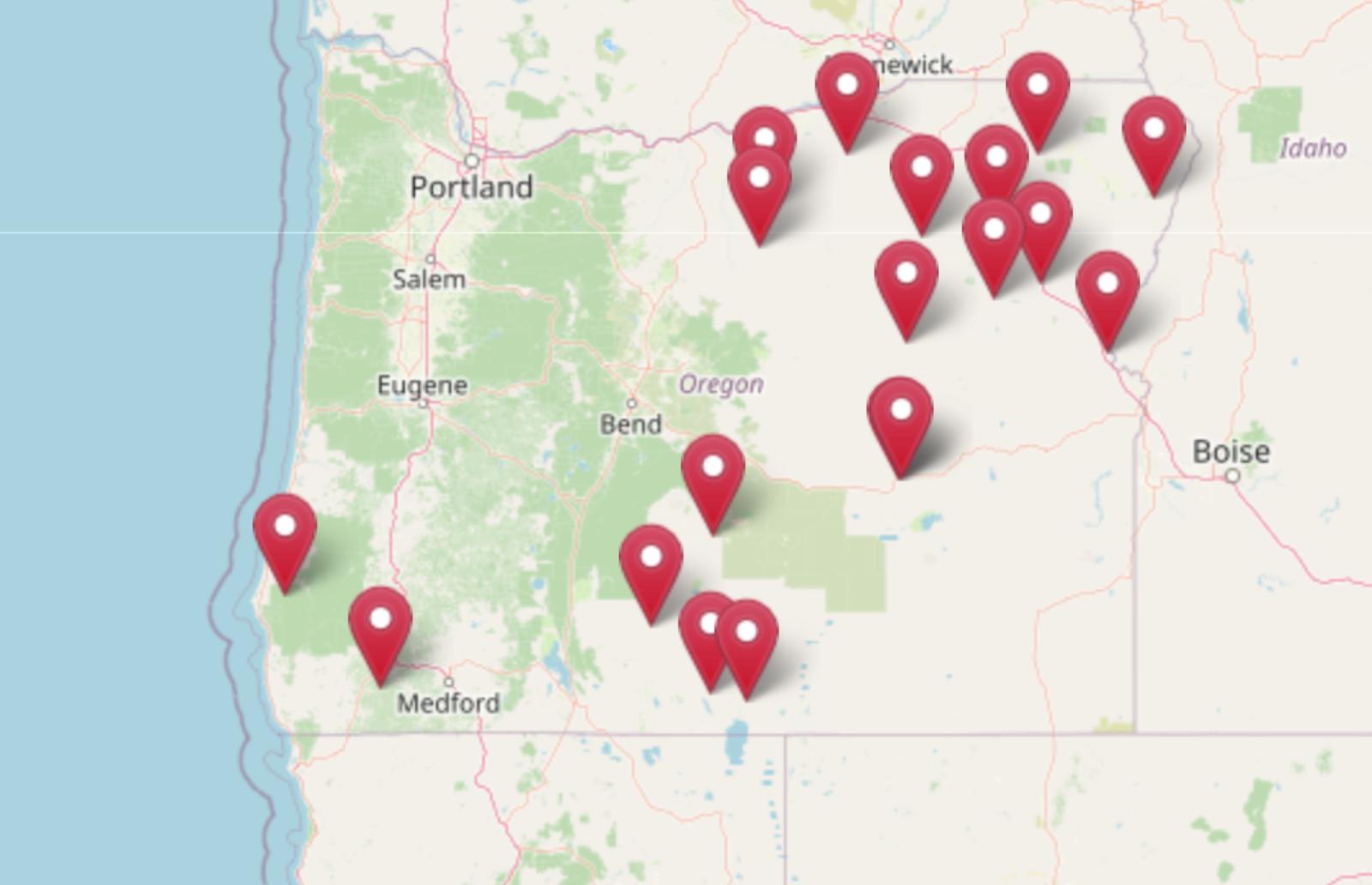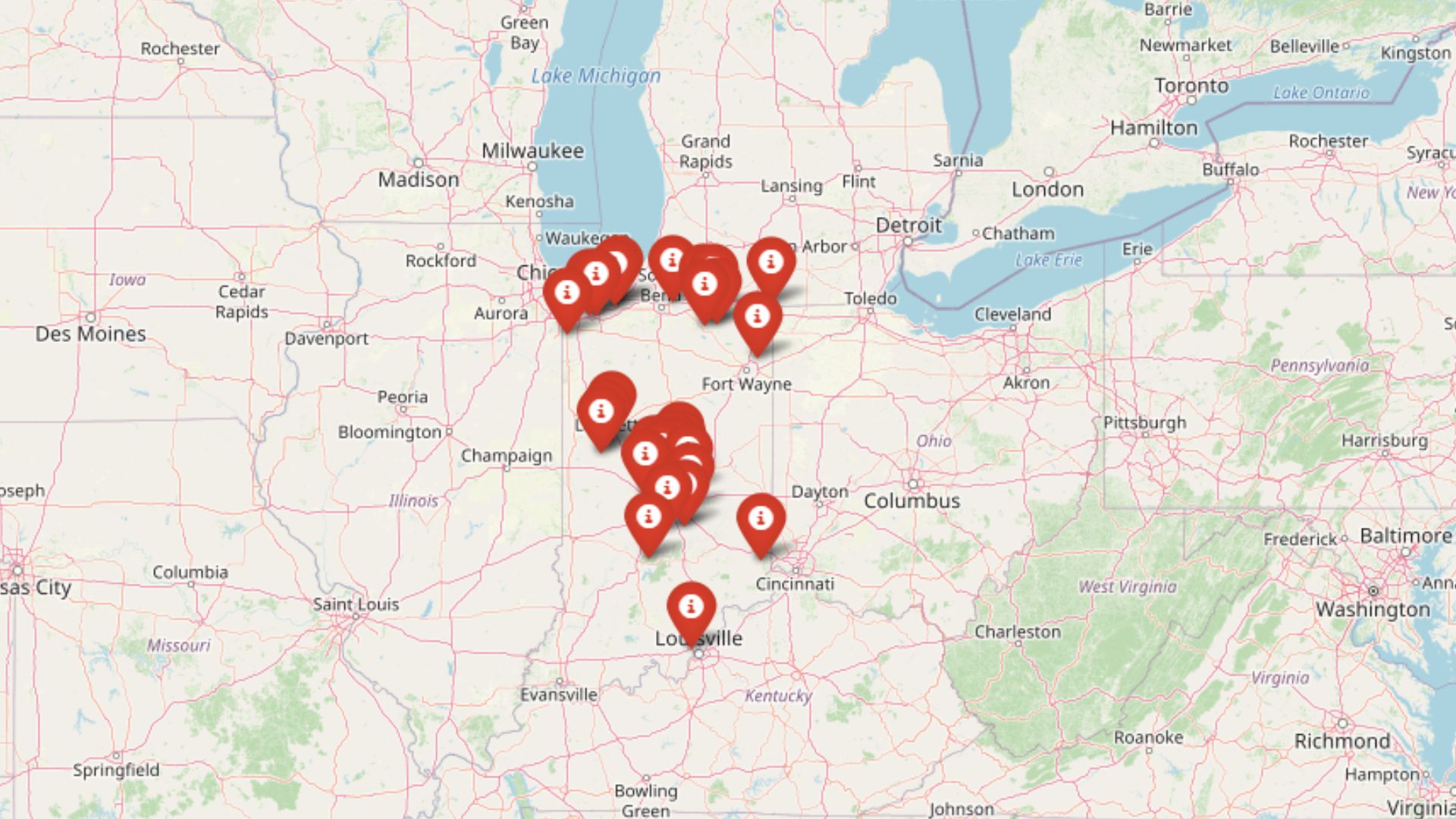
Using the latest Zillow Home Value Index data from 2025, we’ve ranked the 30 most expensive towns in Indiana based on current home prices. These communities represent more than just high price tags—they showcase areas where property values have surged dramatically, some doubling or even tripling since 2010.
From exclusive lakefront retreats along Lake Michigan to thriving suburbs surrounding Indianapolis, each town tells a story of growth and demand. The data reveals patterns that might surprise you, with some smaller communities outpacing major cities in appreciation rates while others maintain steady, premium pricing year after year.
30. Whitestown – 102% Home Price Increase Since 2010
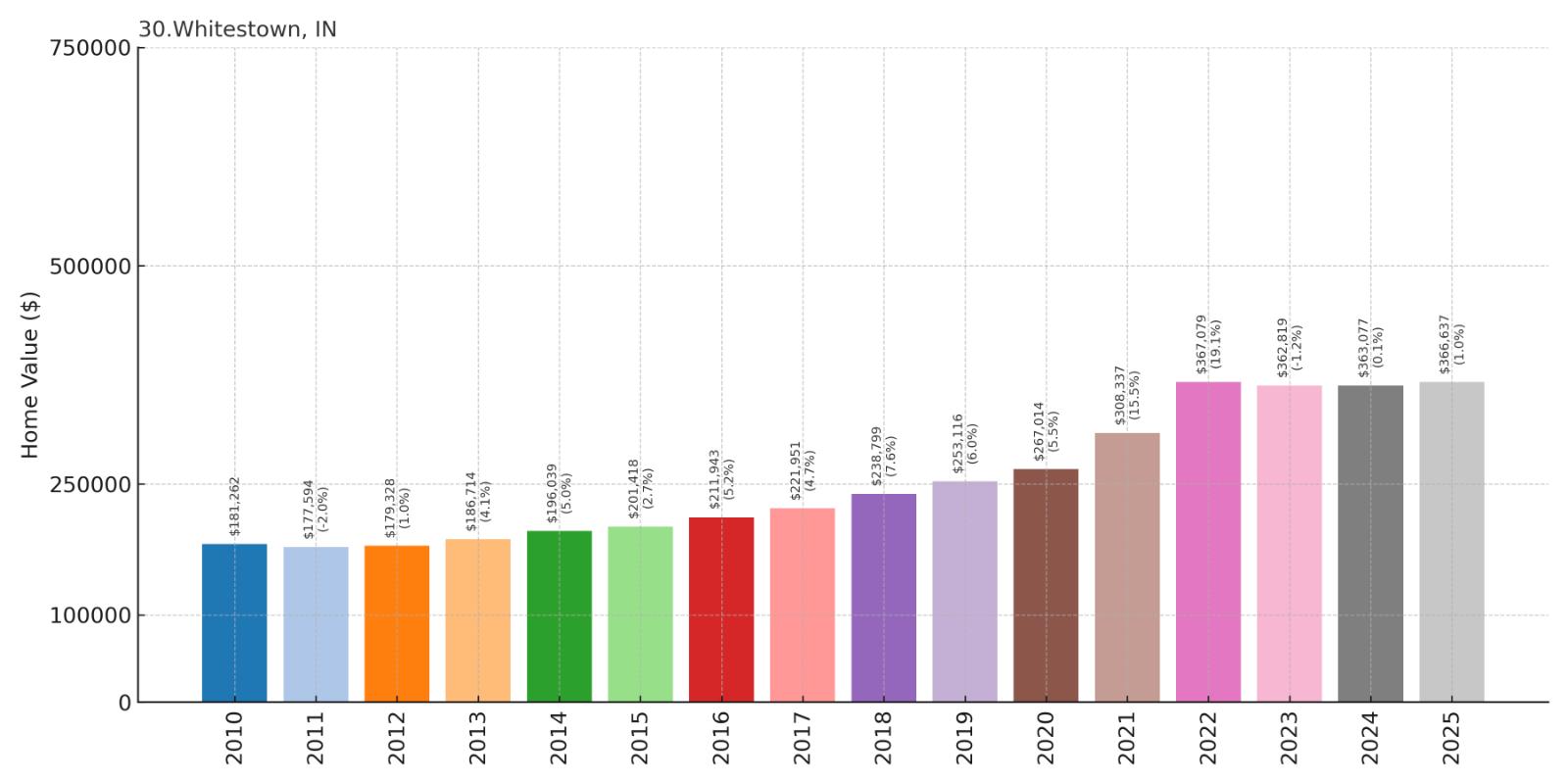
- 2010: $181,262
- 2011: $177,594
- 2012: $179,328
- 2013: $186,714
- 2014: $196,039
- 2015: $201,418
- 2016: $211,943
- 2017: $221,951
- 2018: $238,799
- 2019: $253,116
- 2020: $267,014
- 2021: $308,337
- 2022: $367,079
- 2023: $362,819
- 2024: $363,077
- 2025: $366,637
Whitestown has more than doubled in value since 2010, with current median home prices at $366,637. The most explosive growth happened between 2020 and 2022, when prices jumped over 37%. This Boone County town has transformed from a quiet farming community into a sought-after suburban destination.
Why Whitestown?

Why are people willing to pay so much to live here? What’s special about it?
Whitestown attracts families seeking new construction homes in planned communities with modern amenities. The town offers excellent schools, low crime rates, and easy access to Interstate 65, making commutes to Indianapolis manageable. Unlike older suburbs, Whitestown features contemporary neighborhoods with walking trails, parks, and family-friendly layouts.
The combination of affordable land for development and proximity to job centers has created a perfect storm for growth. New residents appreciate the small-town feel while having access to big-city conveniences just 20 minutes away.
How Whitestown Rose to Prominence
Whitestown’s transformation began in the 1990s as Indianapolis suburbs expanded northward along major highways. Originally founded in 1851 by settlers from the Carolinas, the town remained primarily agricultural until recent decades. The completion of Interstate 65 and improved road connections made the area attractive for residential development.
Major housing developments started appearing in the 2000s, accelerating after the 2008 recession as builders sought affordable land. The town’s strategic location between Indianapolis and Lafayette, combined with business-friendly policies, attracted both residents and commercial development. Corporate relocations and the growth of nearby business parks have solidified Whitestown as a desirable suburban destination.
3 Interesting Tidbits
- Rapid Growth – Whitestown’s population has grown from around 1,000 residents in 2000 to over 9,000 today, making it one of Indiana’s fastest-growing towns.
- Sports Hub – The town is home to the Grand Park Sports Campus, one of the largest youth sports facilities in the United States, hosting national tournaments and bringing thousands of visitors annually.
- Tech Corridor – Whitestown sits along the emerging tech corridor between Indianapolis and Purdue University, attracting tech workers and companies seeking lower costs than urban areas.
29. Pittsboro – 112% Home Price Increase Since 2010
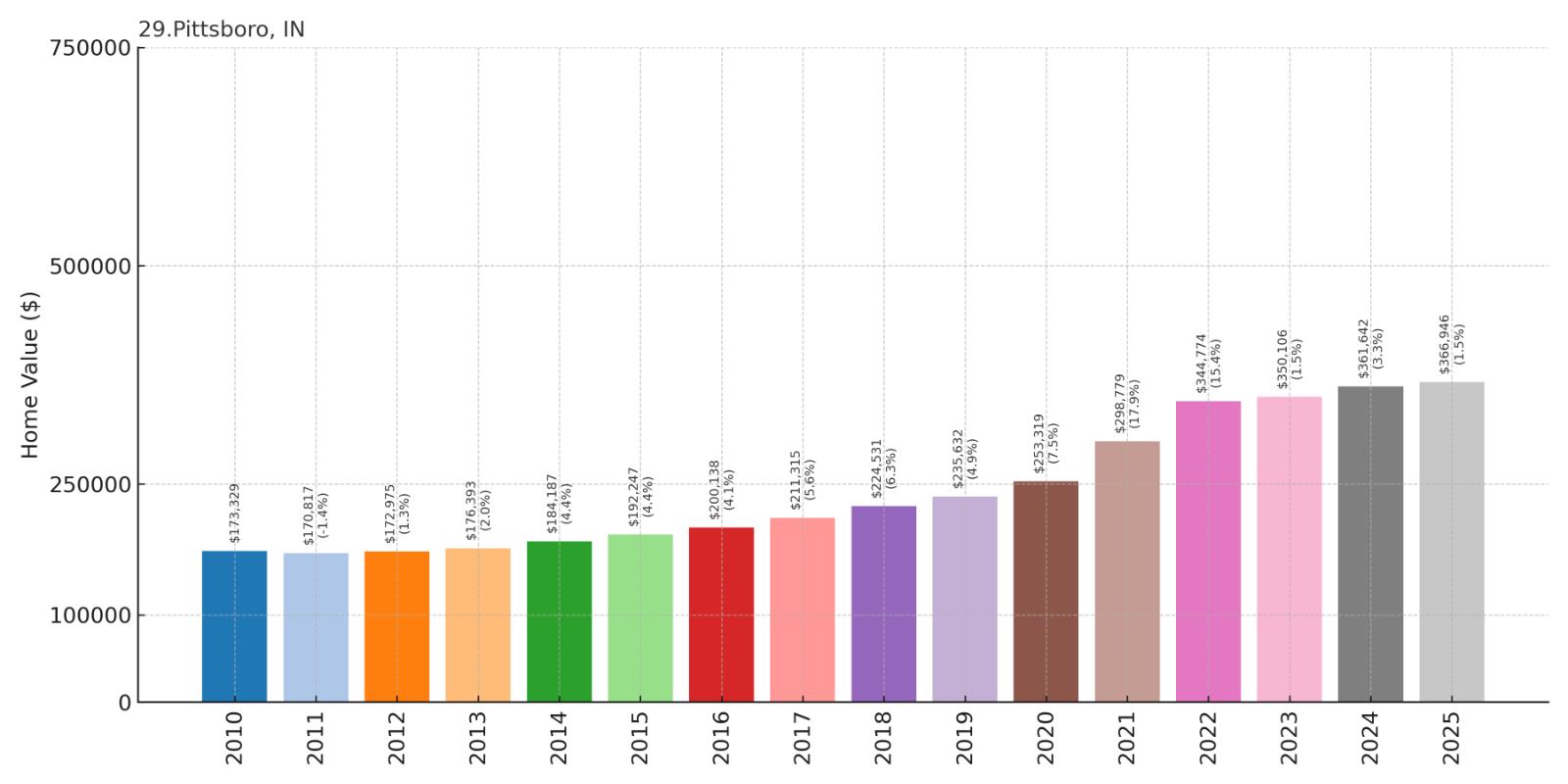
- 2010: $173,329
- 2011: $170,817
- 2012: $172,975
- 2013: $176,393
- 2014: $184,187
- 2015: $192,247
- 2016: $200,138
- 2017: $211,315
- 2018: $224,531
- 2019: $235,632
- 2020: $253,319
- 2021: $298,779
- 2022: $344,774
- 2023: $350,106
- 2024: $361,642
- 2025: $366,946
Pittsboro has delivered strong returns with home values more than doubling since 2010, now reaching $366,946. The pandemic years of 2021-2022 saw dramatic growth exceeding 40% over two years. This Hendricks County community benefits from proximity to Indianapolis International Airport and major employment centers.
Why Pittsboro?
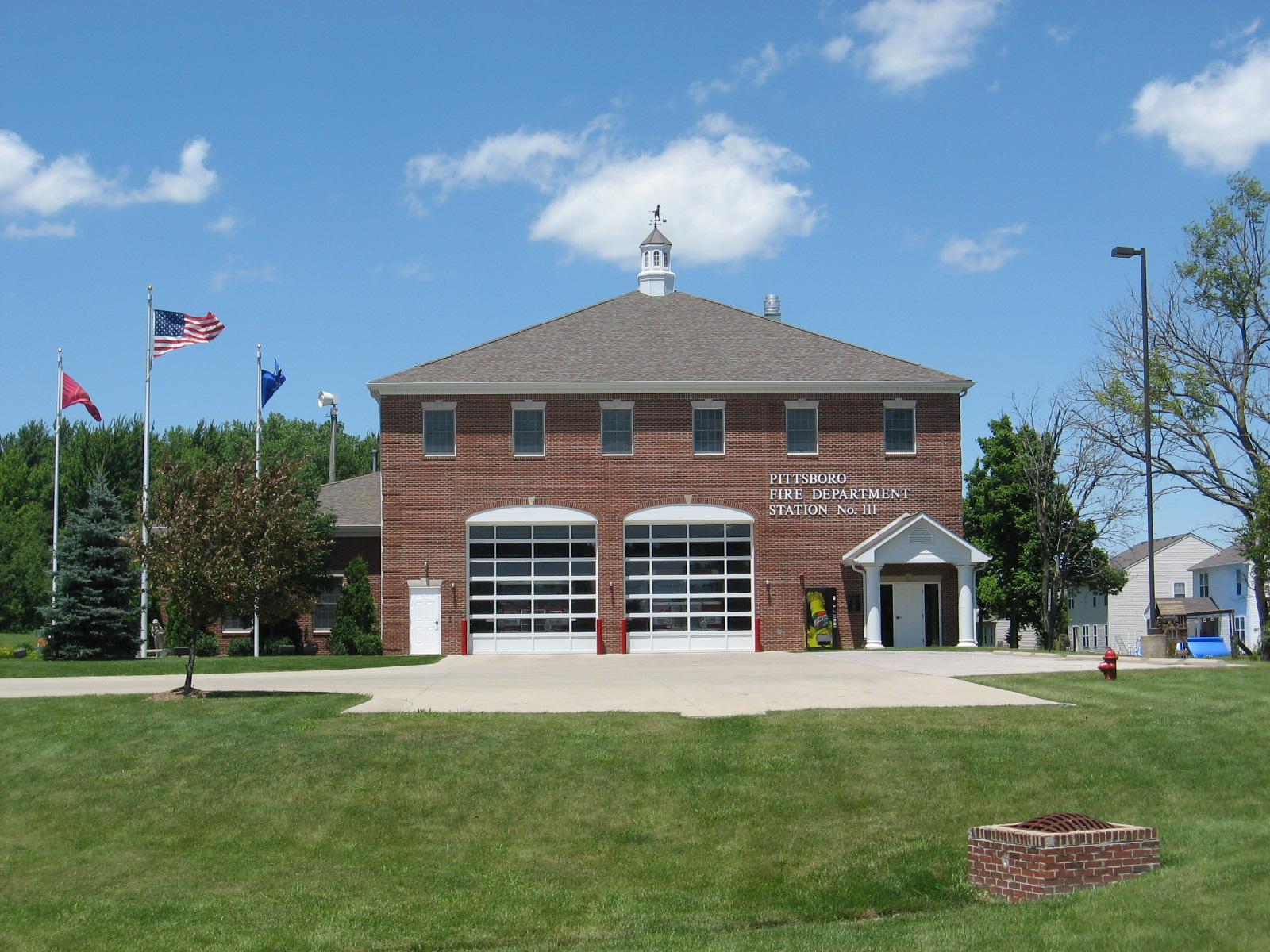
Why are people willing to pay so much to live here? What’s special about it?
Pittsboro offers a rural lifestyle with urban convenience, featuring historic downtown charm and newer suburban developments. Families appreciate the highly rated North West Hendricks Schools and the town’s safe, community-oriented atmosphere. The location provides easy access to Indianapolis jobs while maintaining lower property taxes than Marion County.
Large lot sizes and custom home opportunities attract buyers looking for space and privacy. The town successfully balances growth with preservation, maintaining its small-town character while adding modern amenities and services.
How Pittsboro Rose to Prominence
Founded in 1834, Pittsboro was originally a railroad town that served as a supply center for surrounding farms. The arrival of the Indianapolis and Bellefontaine Railroad in the 1850s established the town as a transportation hub. Agriculture dominated the economy well into the 20th century, with grain elevators and farm implement dealers forming the business core.
The town’s modern growth began in the 1980s as Indianapolis suburbs expanded westward. Developers recognized the appeal of Pittsboro’s rural setting combined with good highway access. The completion of Ronald Reagan Parkway and improvements to US Route 36 dramatically reduced commute times to Indianapolis, spurring residential development. Corporate growth at Indianapolis International Airport and nearby business parks has made Pittsboro increasingly attractive to professionals.
3 Interesting Tidbits
- Railroad Heritage – The historic Pittsboro depot, built in 1907, still stands as a reminder of the town’s railroad origins and houses local historical displays.
- Festival Town – Pittsboro hosts an annual Fall Festival that draws thousands of visitors with crafts, food, and entertainment, celebrating the town’s community spirit.
- Airport Access – The town is just 15 minutes from Indianapolis International Airport, making it popular with frequent travelers and aviation industry workers.
28. Middlebury – 124% Home Price Increase Since 2010
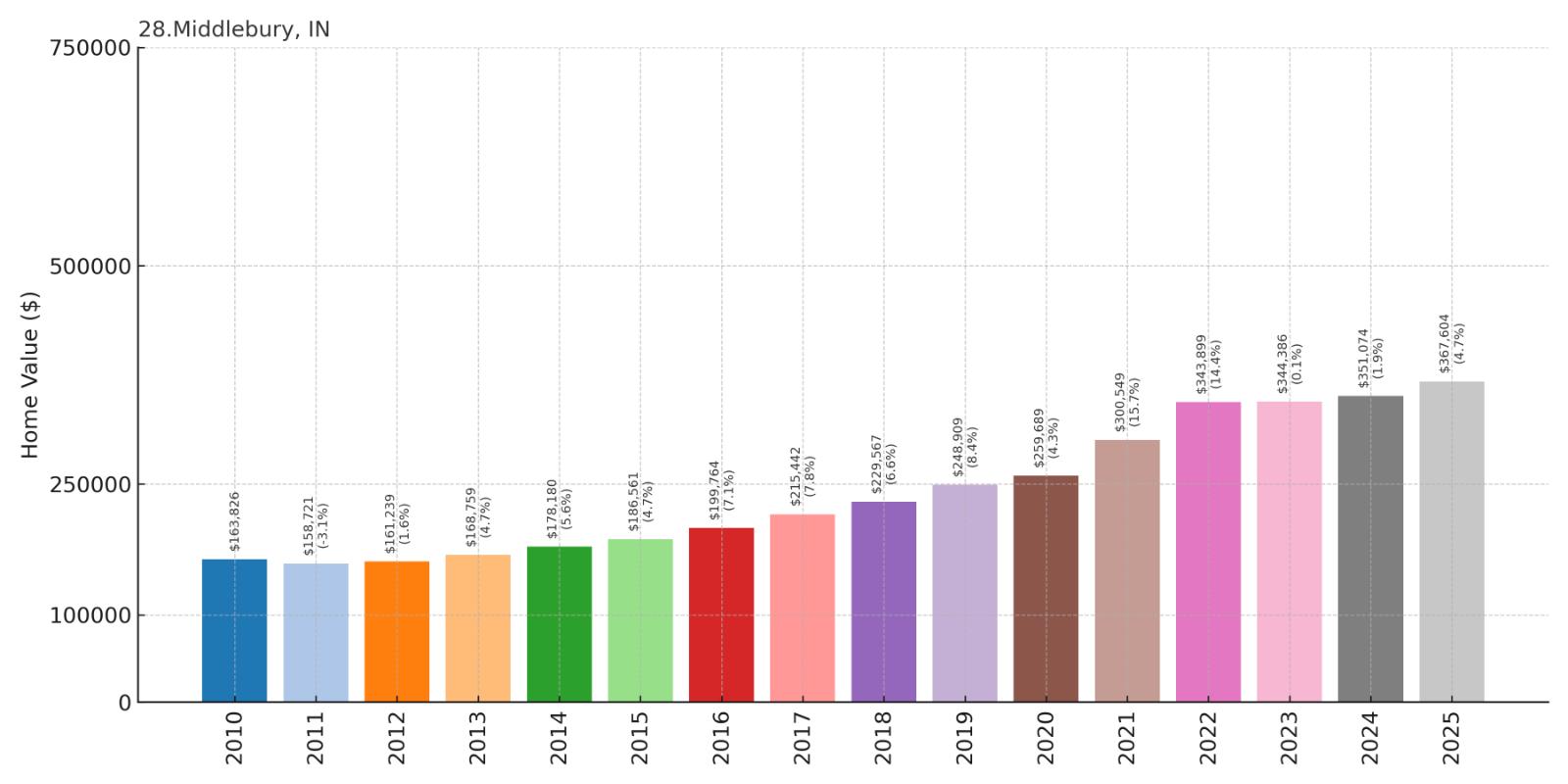
- 2010: $163,826
- 2011: $158,721
- 2012: $161,239
- 2013: $168,759
- 2014: $178,180
- 2015: $186,561
- 2016: $199,764
- 2017: $215,442
- 2018: $229,567
- 2019: $248,909
- 2020: $259,689
- 2021: $300,549
- 2022: $343,899
- 2023: $344,386
- 2024: $351,074
- 2025: $367,604
Middlebury has achieved impressive 124% growth since 2010, with homes now valued at $367,604. The town experienced steady appreciation through the 2010s before accelerating dramatically during the pandemic. Located in Elkhart County, Middlebury benefits from the region’s strong manufacturing economy and recreational vehicle industry.
Why Middlebury?

Why are people willing to pay so much to live here? What’s special about it?
Middlebury attracts residents with its blend of small-town charm and economic opportunity in Indiana’s RV capital region. The town offers excellent schools, safe neighborhoods, and a strong sense of community. Many residents work in the thriving RV manufacturing industry, which provides stable, well-paying jobs.
The area’s Amish community adds unique cultural richness, with locally made furniture, fresh produce, and traditional craftsmanship. Middlebury’s location near recreational lakes and state parks appeals to outdoor enthusiasts seeking both employment and recreation.
How Middlebury Rose to Prominence
Established in 1838, Middlebury began as a farming community in the heart of what would become Indiana’s Amish country. The town’s growth accelerated in the early 20th century with the development of small manufacturing businesses. The post-World War II boom brought the recreational vehicle industry to Elkhart County, transforming the regional economy.
Major RV manufacturers like Forest River and Keystone established operations nearby, creating thousands of jobs and attracting workers to the area. Middlebury benefited from this industrial growth while maintaining its small-town character. The town’s strategic location between South Bend and Fort Wayne, combined with the stability of the RV industry, has made it an attractive place to live and work.
3 Interesting Tidbits
- RV Capital Connection – Middlebury sits in the heart of Elkhart County, which produces about 80% of all recreational vehicles manufactured in the United States.
- Amish Influence – The town is surrounded by one of the largest Amish communities in the country, creating a unique cultural and economic environment.
- Crystal Valley – Nearby Crystal Valley is home to the Das Dutchman Essenhaus, a massive Amish-themed restaurant and shopping complex that draws tourists from across the Midwest.
27. West Lafayette – 98% Home Price Increase Since 2010
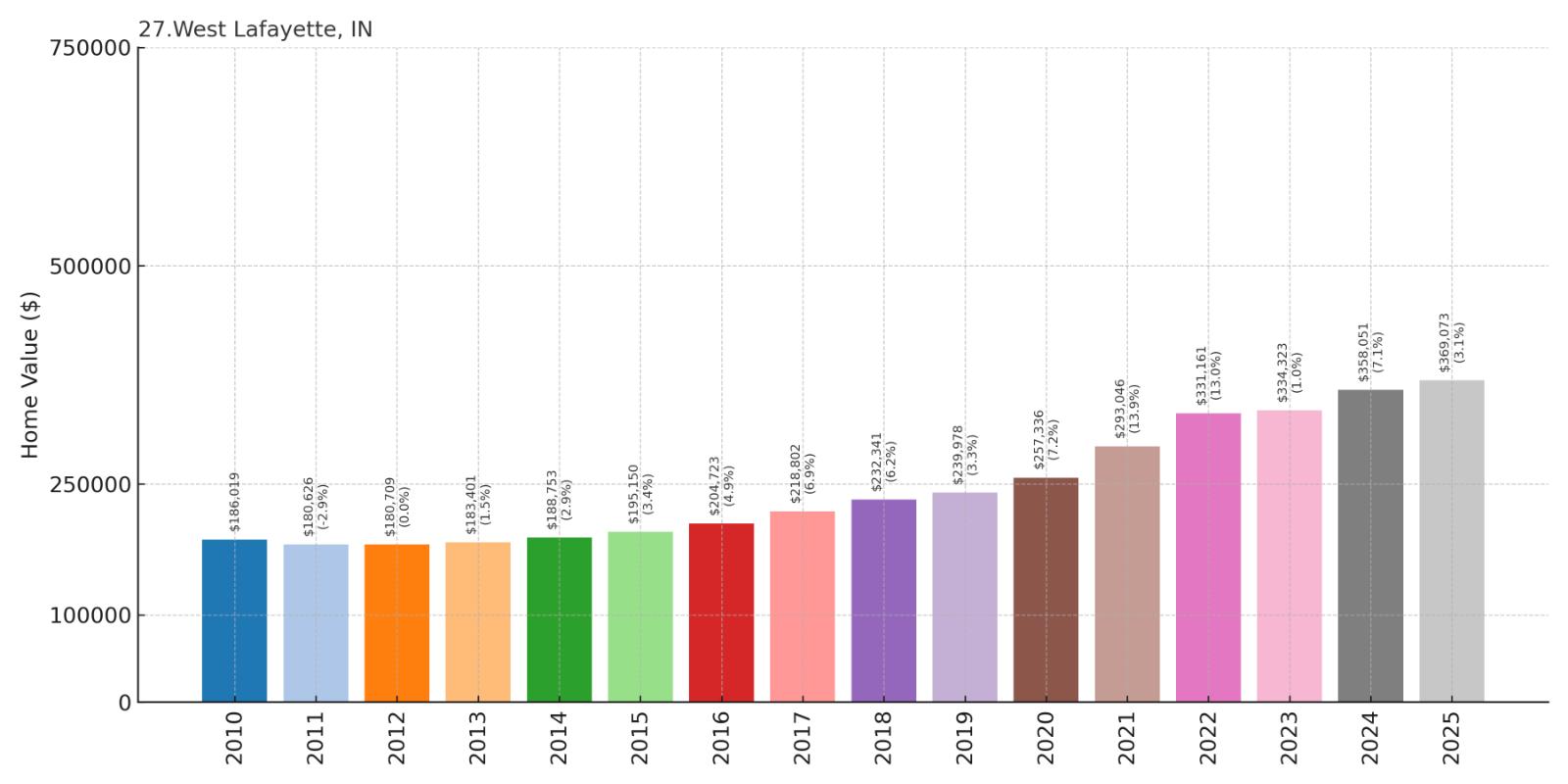
- 2010: $186,019
- 2011: $180,626
- 2012: $180,709
- 2013: $183,401
- 2014: $188,753
- 2015: $195,150
- 2016: $204,723
- 2017: $218,802
- 2018: $232,341
- 2019: $239,978
- 2020: $257,336
- 2021: $293,046
- 2022: $331,161
- 2023: $334,323
- 2024: $358,051
- 2025: $369,073
West Lafayette has nearly doubled in value since 2010, reaching $369,073 by 2025. The college town experienced steady growth through the 2010s with acceleration after 2020. Home to Purdue University, West Lafayette benefits from constant demand driven by faculty, staff, and graduate students seeking quality housing.
Why West Lafayette?
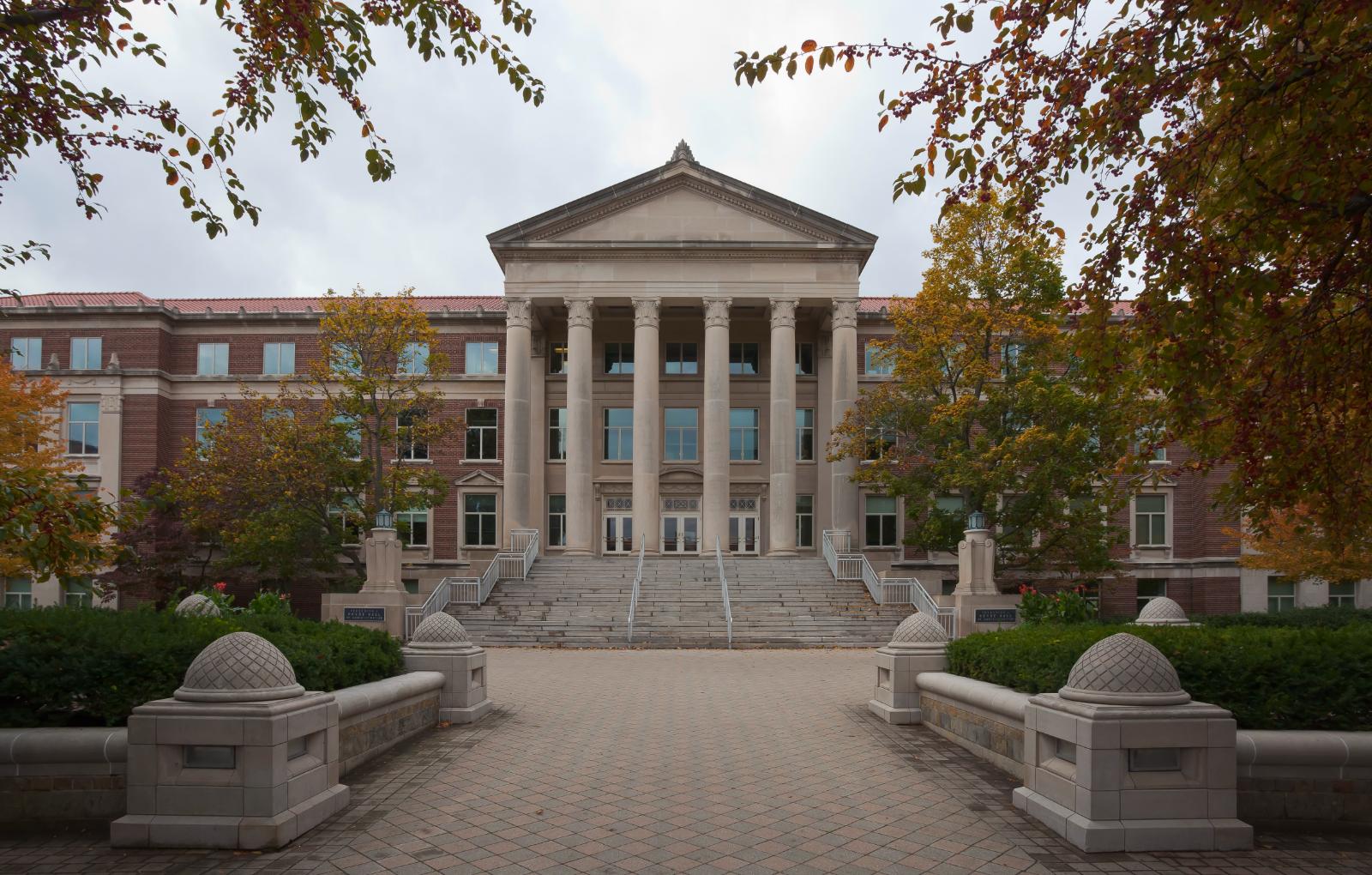
Why are people willing to pay so much to live here? What’s special about it?
West Lafayette offers the cultural and intellectual benefits of a major university town while maintaining affordable living compared to coastal college communities. Purdue University provides stability, cultural activities, and a constant influx of educated residents. The town features excellent schools, walkable neighborhoods, and a vibrant downtown.
The combination of university jobs, research opportunities, and spin-off businesses creates a diverse economy. Residents appreciate the college town atmosphere with its restaurants, entertainment, and educational opportunities, plus easy access to outdoor recreation along the Wabash River.
How West Lafayette Rose to Prominence
West Lafayette’s destiny changed forever in 1869 when Purdue University was established on the west side of the Wabash River. The town incorporated in 1888, growing alongside the university as faculty and staff needed housing and services. The presence of a major land-grant university brought stability and intellectual capital to the region.
Throughout the 20th century, Purdue’s growth in engineering, agriculture, and technology attracted research facilities and high-tech companies to the area. The university’s reputation for innovation, particularly in aerospace and technology, has made West Lafayette a hub for educated professionals. Recent decades have seen significant investment in downtown redevelopment and mixed-use projects, making the town increasingly attractive to both university-affiliated and non-university residents.
3 Interesting Tidbits
- Boilermaker Central – West Lafayette is home to Ross-Ade Stadium and Mackey Arena, where Purdue’s Boilermakers compete in Big Ten athletics before passionate crowds.
- Innovation District – The town is part of the Purdue Research Park, one of the largest university-affiliated business incubation centers in the country.
- Historic Bridge – The town is connected to Lafayette by several bridges spanning the Wabash River, including the historic Harrison Street Bridge built in 1940.
26. Westpoint – 109% Home Price Increase Since 2010
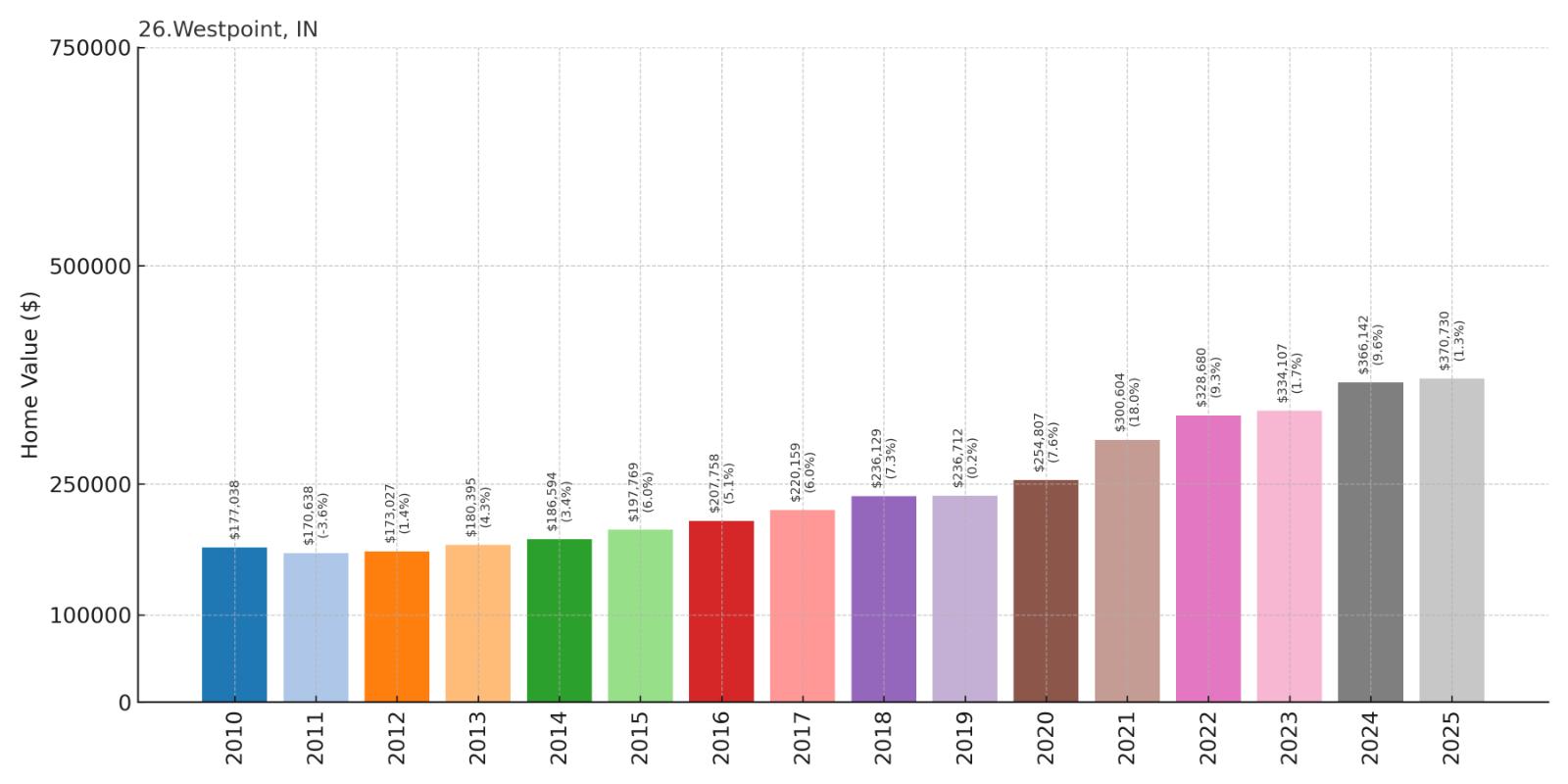
- 2010: $177,038
- 2011: $170,638
- 2012: $173,027
- 2013: $180,395
- 2014: $186,594
- 2015: $197,769
- 2016: $207,758
- 2017: $220,159
- 2018: $236,129
- 2019: $236,712
- 2020: $254,807
- 2021: $300,604
- 2022: $328,680
- 2023: $334,107
- 2024: $366,142
- 2025: $370,730
Westpoint has shown impressive growth with a 109% increase since 2010, reaching $370,730 in 2025. The Tippecanoe County community experienced steady appreciation through the decade with notable acceleration in 2024. This small town benefits from proximity to Lafayette and West Lafayette employment centers.
Why Westpoint?

Why are people willing to pay so much to live here? What’s special about it?
Westpoint appeals to buyers seeking rural tranquility with urban accessibility, offering larger lots and newer construction at competitive prices. The town provides a quiet, family-friendly environment while maintaining reasonable commutes to Lafayette-West Lafayette jobs. Low crime rates and strong community bonds attract families looking for small-town values.
The area offers excellent outdoor recreation opportunities with nearby parks, lakes, and the Wabash River. Residents appreciate the peaceful setting and space for hobbies, gardening, and outdoor activities while staying connected to educational and employment opportunities.
How Westpoint Rose to Prominence
Founded in 1872 along the Wabash Railroad, Westpoint served as a grain shipping point for surrounding farms. The town remained primarily agricultural through most of the 20th century, with grain elevators and farm supply stores forming the economic base. The arrival of Purdue University nearby gradually increased demand for housing.
Modern growth began in the 1990s as Lafayette-West Lafayette expanded and housing costs in urban areas increased. Westpoint offered affordable land for new construction while providing reasonable access to university and corporate jobs. The town’s location along major transportation routes made it attractive to commuters seeking more space and lower costs than urban alternatives.
3 Interesting Tidbits
- Railroad Legacy – The town’s grain elevator, visible for miles, stands as a testament to Westpoint’s agricultural heritage and railroad connections.
- Commuter Haven – Despite its rural setting, Westpoint is just 20 minutes from Purdue University and major Lafayette employers.
- Growing Community – The town has seen significant new residential development in recent years, attracting young families and professionals seeking affordable housing.
25. Shipshewana – 133% Home Price Increase Since 2010
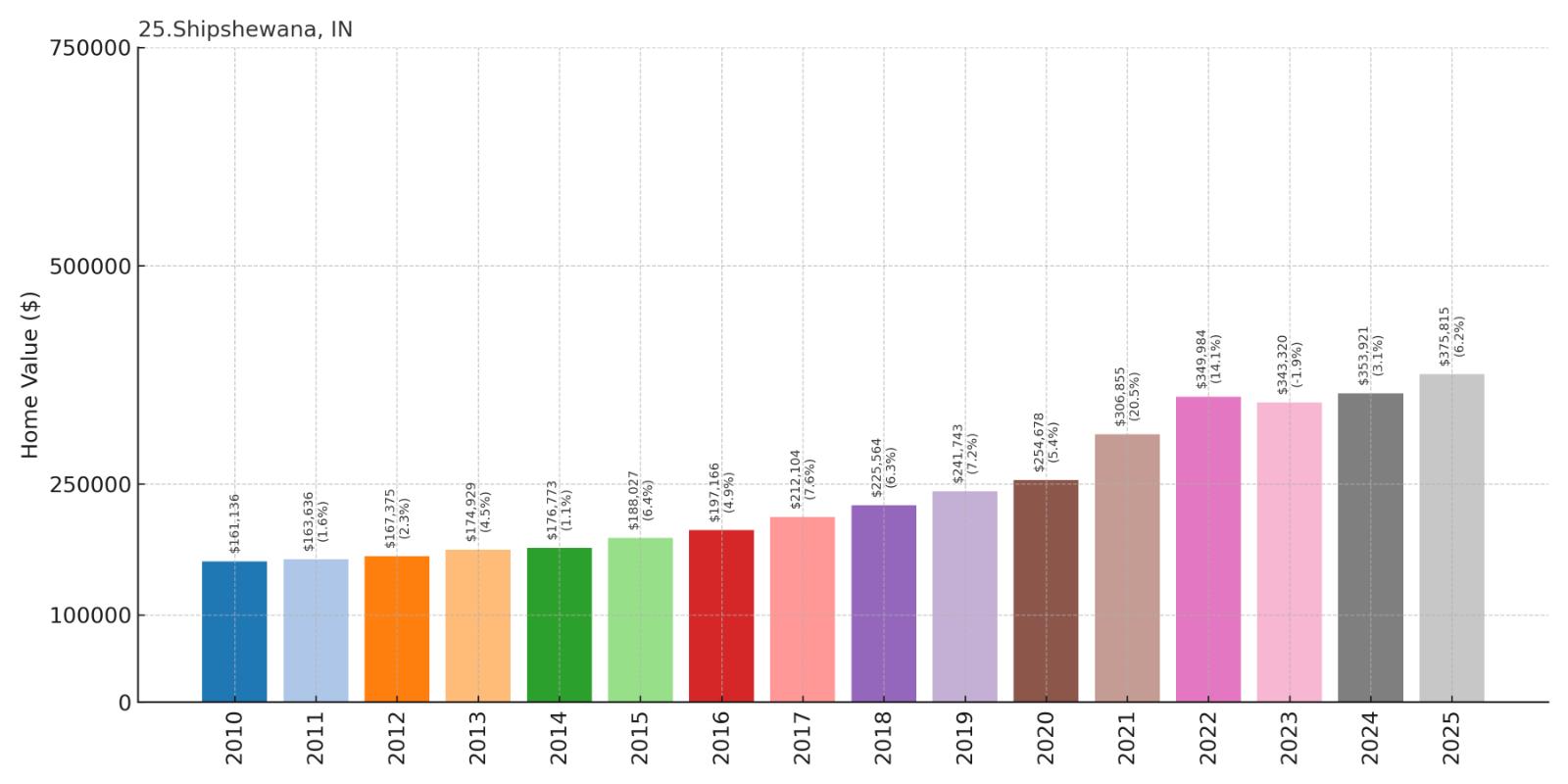
- 2010: $161,136
- 2011: $163,636
- 2012: $167,375
- 2013: $174,929
- 2014: $176,773
- 2015: $188,027
- 2016: $197,166
- 2017: $212,104
- 2018: $225,564
- 2019: $241,743
- 2020: $254,678
- 2021: $306,855
- 2022: $349,984
- 2023: $343,320
- 2024: $353,921
- 2025: $375,815
Shipshewana has achieved remarkable 133% growth since 2010, with median home prices now at $375,815. The LaGrange County town experienced particularly strong growth during the pandemic years, when values jumped over 35%. This unique community serves as the unofficial capital of Indiana’s Amish region.
Why Shipshewana?
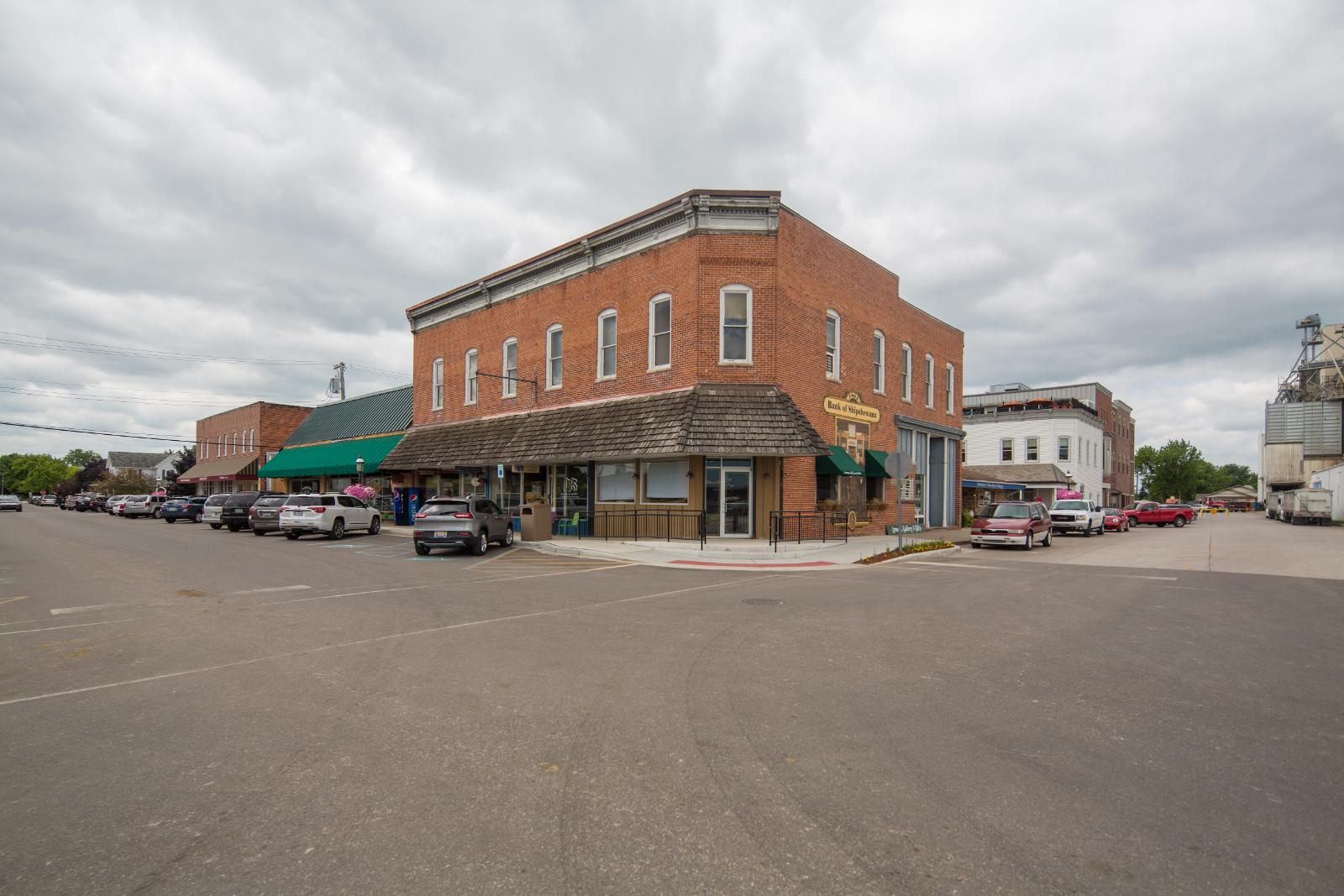
Why are people willing to pay so much to live here? What’s special about it?
Shipshewana offers an authentic Amish country experience with one of the Midwest’s largest flea markets and antique auctions drawing hundreds of thousands of visitors annually. The town provides unique investment opportunities in tourism-related properties and vacation rentals. Residents appreciate the peaceful, traditional lifestyle and strong community values.
The area’s reputation for quality craftsmanship, particularly in furniture and construction, attracts buyers seeking well-built homes. The combination of tourism income potential and rural charm makes Shipshewana appealing to both investors and those seeking a quieter lifestyle.
How Shipshewana Rose to Prominence
Shipshewana was founded in 1889 and named after Chief Shipshewana of the Potawatomi tribe. The town’s character was shaped by the arrival of Amish and Mennonite families in the early 20th century, who established farms and businesses based on traditional values and craftsmanship. The community’s reputation for quality woodworking and farming attracted visitors seeking authentic handmade goods.
The transformation into a tourist destination began in the 1970s with the establishment of the Shipshewana Auction and Flea Market. The twice-weekly events grew to become some of the largest in the Midwest, drawing collectors and tourists from across the country. This tourism boom created demand for restaurants, lodging, and shops, while the area’s scenic beauty and traditional lifestyle attracted new residents seeking a slower pace of life.
3 Interesting Tidbits
- Auction Capital – Shipshewana hosts one of the largest flea markets in the Midwest, with over 700 vendors and thousands of visitors every Tuesday and Wednesday during season.
- Amish Heritage – The town sits in the heart of the third-largest Amish community in the United States, with horse-drawn buggies sharing roads with automobiles.
- Tourism Hub – Despite having only about 650 residents, Shipshewana attracts over one million visitors annually, making tourism a major economic driver.
24. McCordsville – 108% Home Price Increase Since 2010
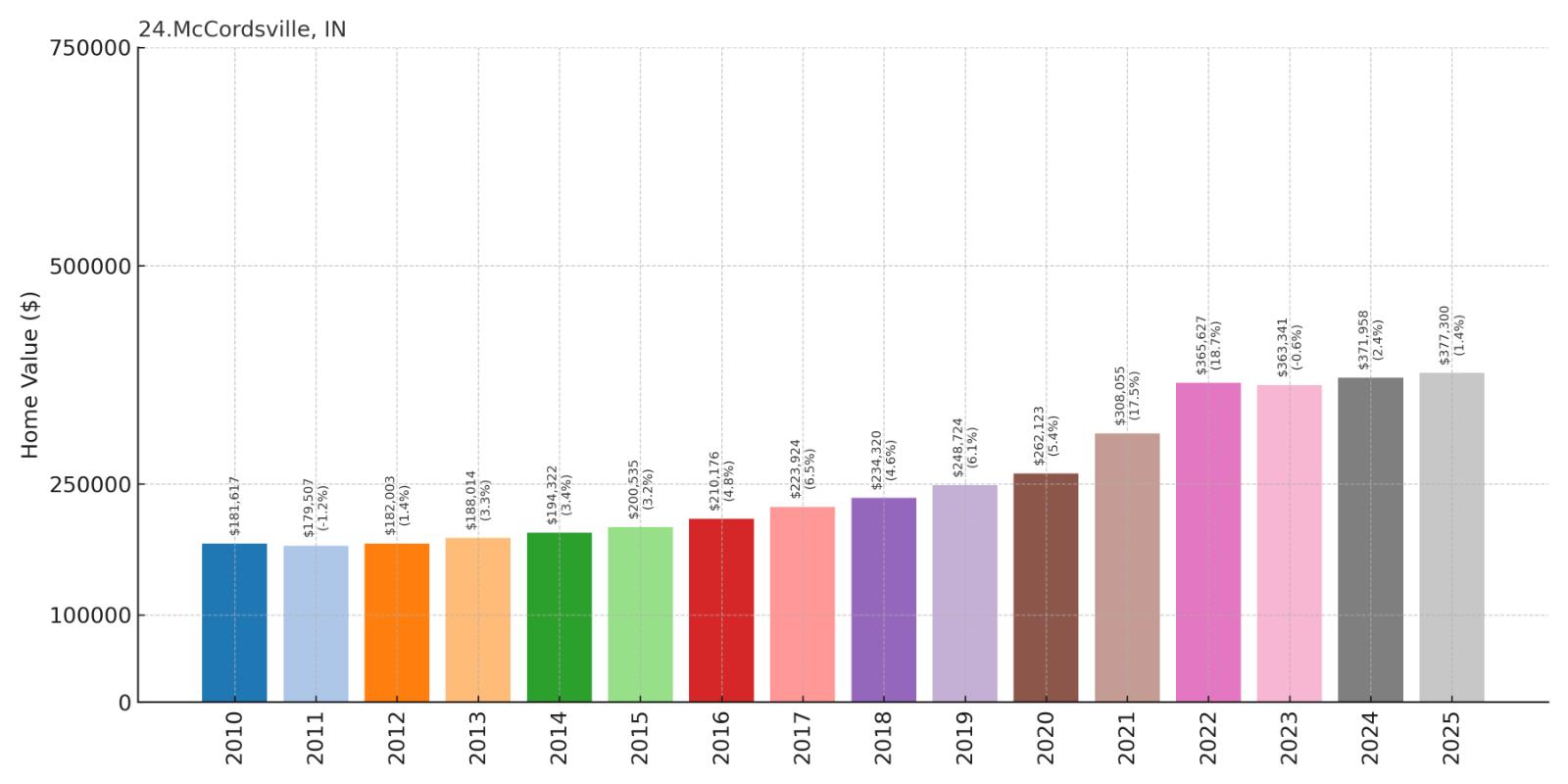
- 2010: $181,617
- 2011: $179,507
- 2012: $182,003
- 2013: $188,014
- 2014: $194,322
- 2015: $200,535
- 2016: $210,176
- 2017: $223,924
- 2018: $234,320
- 2019: $248,724
- 2020: $262,123
- 2021: $308,055
- 2022: $365,627
- 2023: $363,341
- 2024: $371,958
- 2025: $377,300
McCordsville has more than doubled since 2010, reaching $377,300 in 2025 with particularly strong growth in 2021-2022. The Hancock County town benefits from its location on the rapidly growing east side of Indianapolis. New residential developments and excellent schools have attracted families seeking suburban amenities.
Why McCordsville?

Why are people willing to pay so much to live here? What’s special about it?
McCordsville attracts families with its newer planned communities featuring modern homes and amenities like walking trails, parks, and community centers. The town offers highly rated Mt. Vernon Community Schools and easy access to Indianapolis jobs via Interstate 70. Low crime rates and family-friendly neighborhoods create strong demand.
The area provides a suburban lifestyle with room to grow, featuring newer construction and modern infrastructure. Residents appreciate the small-town feel combined with proximity to shopping, dining, and entertainment options in nearby Greenfield and Indianapolis.
How McCordsville Rose to Prominence
McCordsville was incorporated in 1988, making it one of Indiana’s newer municipalities. The town emerged from rural Hancock County farmland as Indianapolis suburbs expanded eastward along Interstate 70. Early development focused on residential subdivisions for families seeking affordable alternatives to more expensive Hamilton County communities.
Growth accelerated in the 2000s as major employers established operations on Indianapolis’s east side and along the I-70 corridor. The town’s strategic location between Indianapolis and the growing Cumberland-Plainfield area made it attractive to commuters. Careful planning and development standards have created cohesive neighborhoods while preserving the small-town character that originally attracted residents.
3 Interesting Tidbits
- Young Community – As one of Indiana’s newer incorporated towns, McCordsville has been planned from the ground up with modern infrastructure and amenities.
- Festival Central – The town hosts the annual Maple Syrup Festival each spring, celebrating local agriculture and community spirit.
- Growth Trajectory – McCordsville’s population has grown from fewer than 1,000 residents in 2000 to over 7,000 today, reflecting its appeal to young families.
23. New Palestine – 112% Home Price Increase Since 2010
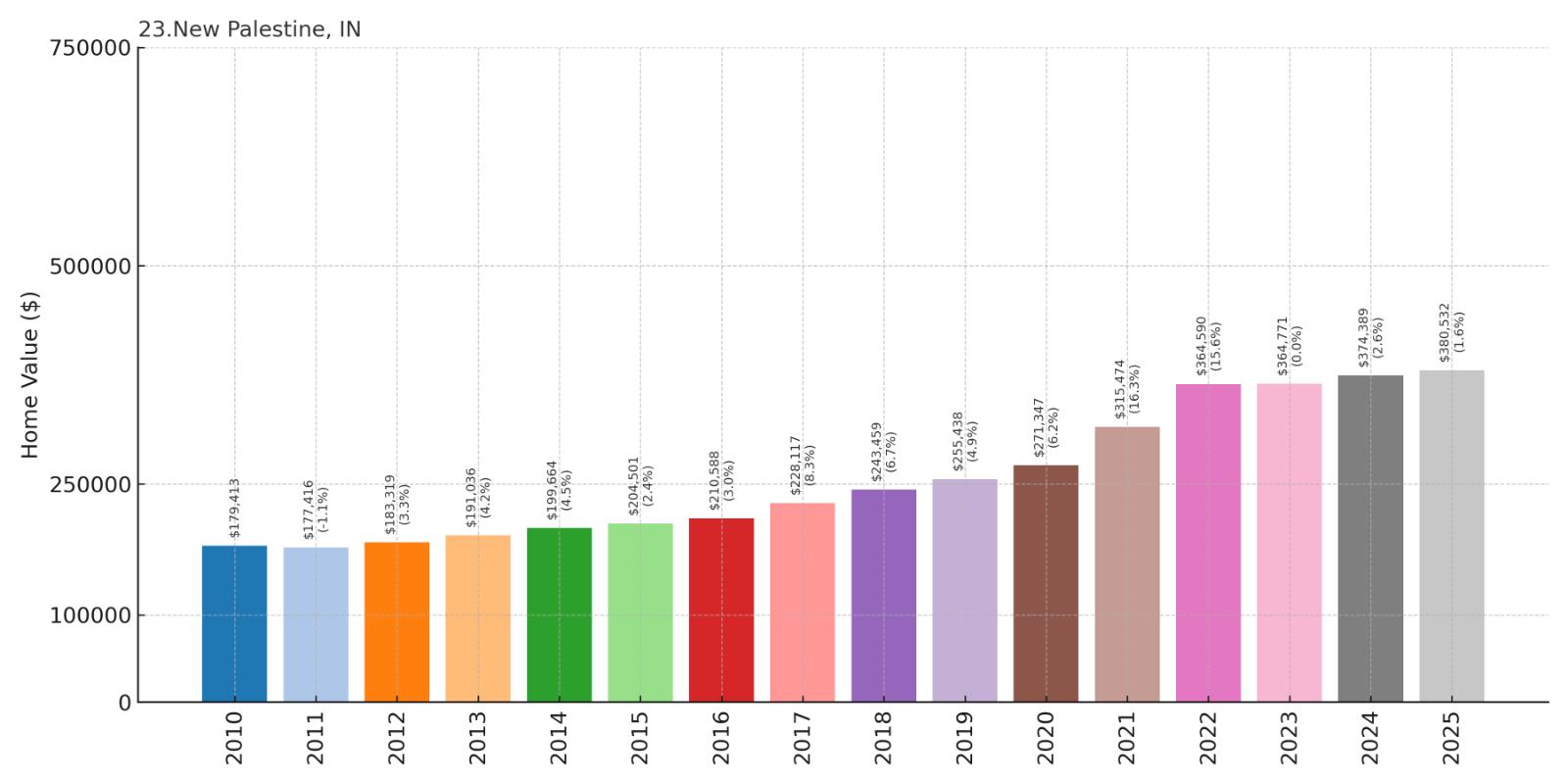
- 2010: $179,413
- 2011: $177,416
- 2012: $183,319
- 2013: $191,036
- 2014: $199,664
- 2015: $204,501
- 2016: $210,588
- 2017: $228,117
- 2018: $243,459
- 2019: $255,438
- 2020: $271,347
- 2021: $315,474
- 2022: $364,590
- 2023: $364,771
- 2024: $374,389
- 2025: $380,532
New Palestine has delivered strong returns with 112% growth since 2010, reaching $380,532 in 2025. The Hancock County community experienced steady appreciation through the 2010s with explosive growth during the pandemic years. The town benefits from excellent schools and proximity to Indianapolis employment centers.
Why New Palestine?
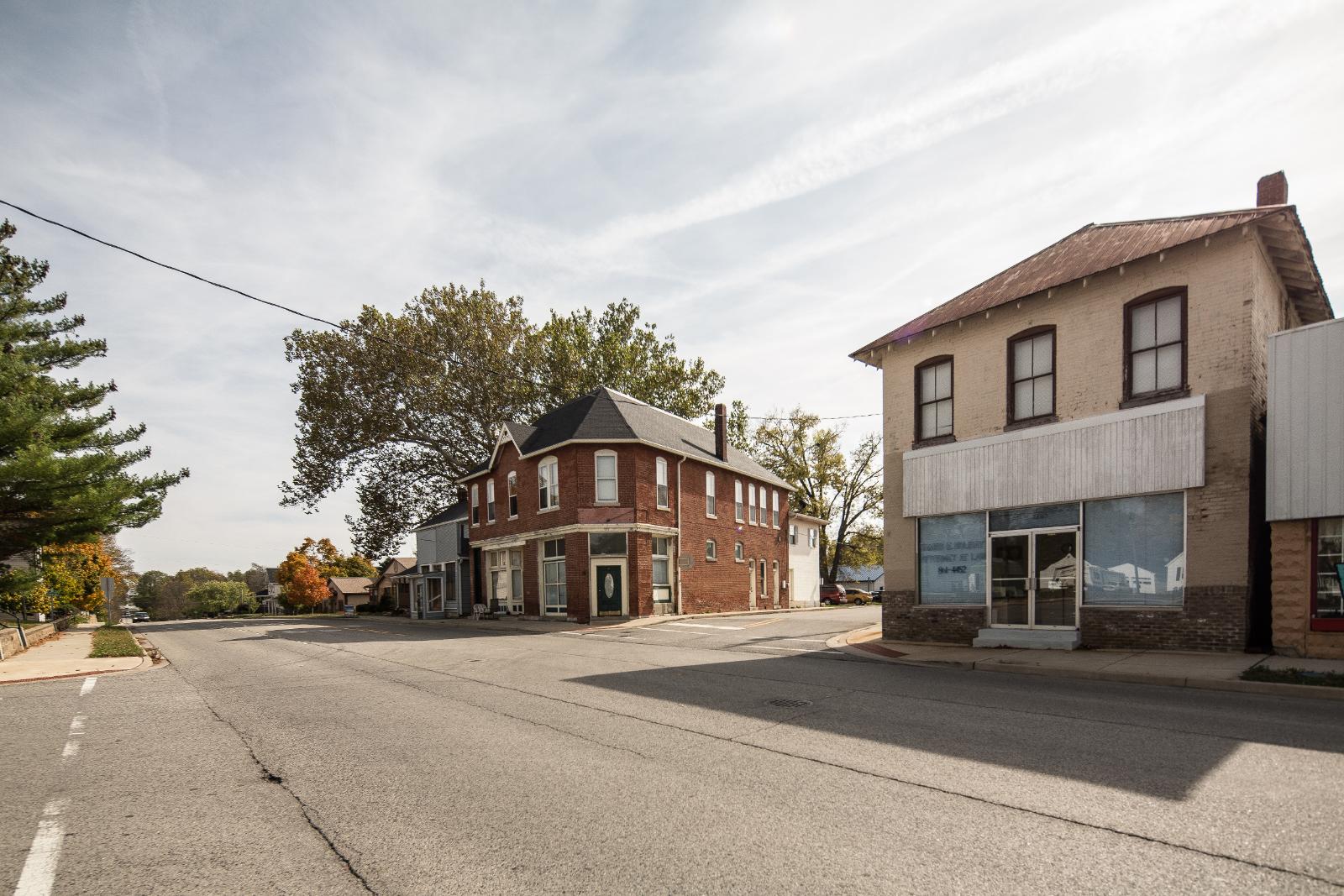
Why are people willing to pay so much to live here? What’s special about it?
New Palestine attracts families with its award-winning Community School Corporation and strong athletic programs, particularly in football and basketball. The town offers a traditional suburban lifestyle with newer developments, parks, and recreational facilities. Easy access to Interstate 70 provides convenient commutes to Indianapolis and beyond.
The community maintains small-town charm while offering modern amenities and services. Residents value the safe neighborhoods, community events, and strong schools that consistently rank among the state’s best, making it particularly appealing to families with children.
How New Palestine Rose to Prominence
Founded in 1838 and incorporated in 1876, New Palestine began as a railroad town along the Indianapolis and Bellefontaine line. The town’s name reportedly came from early settlers who thought the area resembled Palestine in biblical descriptions. Agriculture dominated the economy well into the 20th century, with grain elevators and farm supply stores serving the surrounding rural area.
Modern growth began in the 1980s as Indianapolis expanded eastward and families sought quality schools and affordable housing. The Community School Corporation’s reputation for excellence attracted residents willing to pay premium prices for access to top-rated education. New Palestine High School’s success in athletics, particularly state championships in football, has enhanced the town’s profile and community pride.
3 Interesting Tidbits
- Championship Tradition – New Palestine High School has won multiple state championships in football and consistently ranks among Indiana’s top athletic programs.
- Railroad Heritage – The town’s historic depot has been preserved and serves as a reminder of New Palestine’s origins as a railroad junction.
- School Excellence – The Community School Corporation consistently receives A-ratings from the state and attracts families from neighboring districts.
22. Leo-Cedarville – 112% Home Price Increase Since 2010
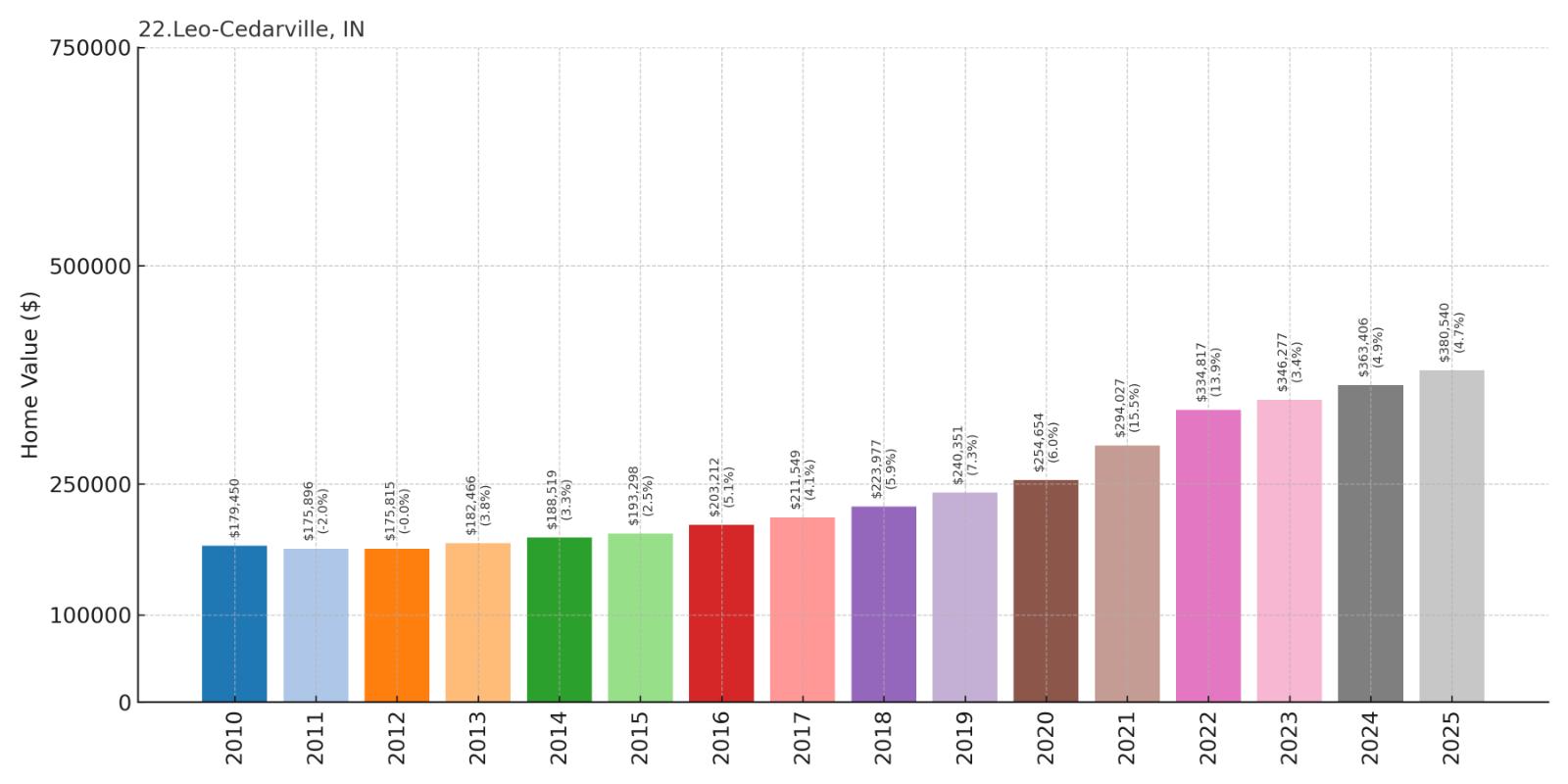
- 2010: $179,450
- 2011: $175,896
- 2012: $175,815
- 2013: $182,466
- 2014: $188,519
- 2015: $193,298
- 2016: $203,212
- 2017: $211,549
- 2018: $223,977
- 2019: $240,351
- 2020: $254,654
- 2021: $294,027
- 2022: $334,817
- 2023: $346,277
- 2024: $363,406
- 2025: $380,540
Leo-Cedarville has more than doubled in value since 2010, now reaching $380,540. The Allen County community showed steady growth through the 2010s before accelerating significantly during the pandemic years. This northeast Indiana town benefits from proximity to Fort Wayne while maintaining a suburban feel.
Why Leo-Cedarville?
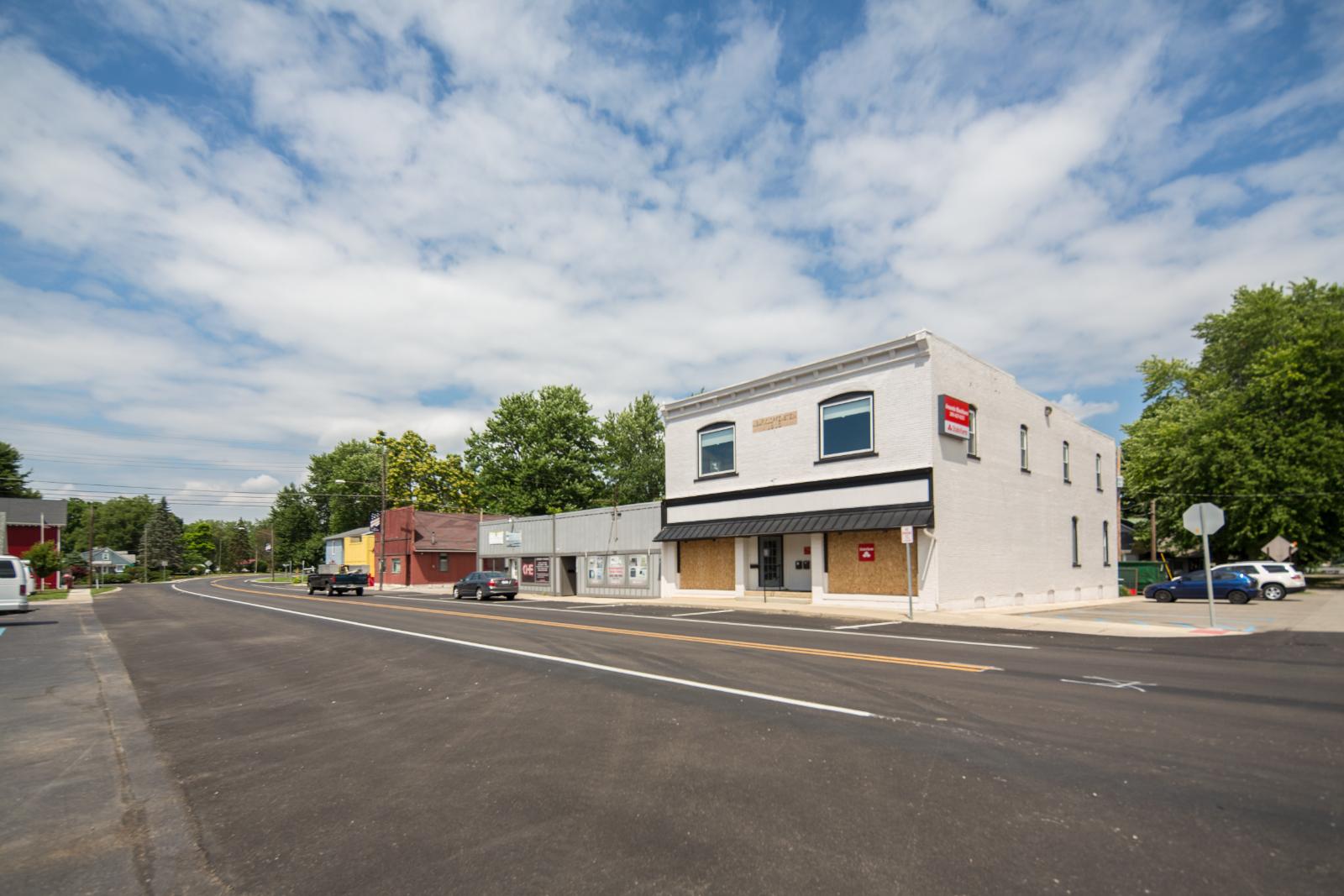
Why are people willing to pay so much to live here? What’s special about it?
Leo-Cedarville attracts residents with its combination of suburban amenities and small-town atmosphere, offering newer housing developments with modern features. The town provides easy access to Fort Wayne employment while maintaining lower property taxes and housing costs than urban areas. Families appreciate the East Allen County Schools system and safe neighborhoods.
The area offers outdoor recreation opportunities with nearby parks and the St. Joseph River. Residents enjoy the community feel with local businesses and restaurants while having quick access to Fort Wayne’s shopping, dining, and entertainment options.
How Leo-Cedarville Rose to Prominence
Leo-Cedarville formed through the merger of two small communities, Leo and Cedarville, in 1994. Leo was established in the 1850s as a railroad stop, while Cedarville developed as a farming community. Both remained largely agricultural until Fort Wayne’s suburban growth reached northeast Allen County in the latter half of the 20th century.
The combined community benefited from Fort Wayne’s economic expansion, particularly in manufacturing and healthcare. The town’s location along major highways provided convenient access to jobs while offering more affordable land for housing developments. Careful planning has preserved the area’s rural character while accommodating growth, making it attractive to families seeking suburban living with small-town values.
3 Interesting Tidbits
- Merged Community – Leo-Cedarville is the result of a 1994 merger between two historic communities, creating a larger, more viable municipality.
- River Access – The town sits along the St. Joseph River, providing opportunities for fishing, canoeing, and other water-based recreation.
- Growing Hub – Leo-Cedarville has become a preferred destination for Fort Wayne commuters seeking newer homes and larger lots at reasonable prices.
21. Unionville – 120% Home Price Increase Since 2010
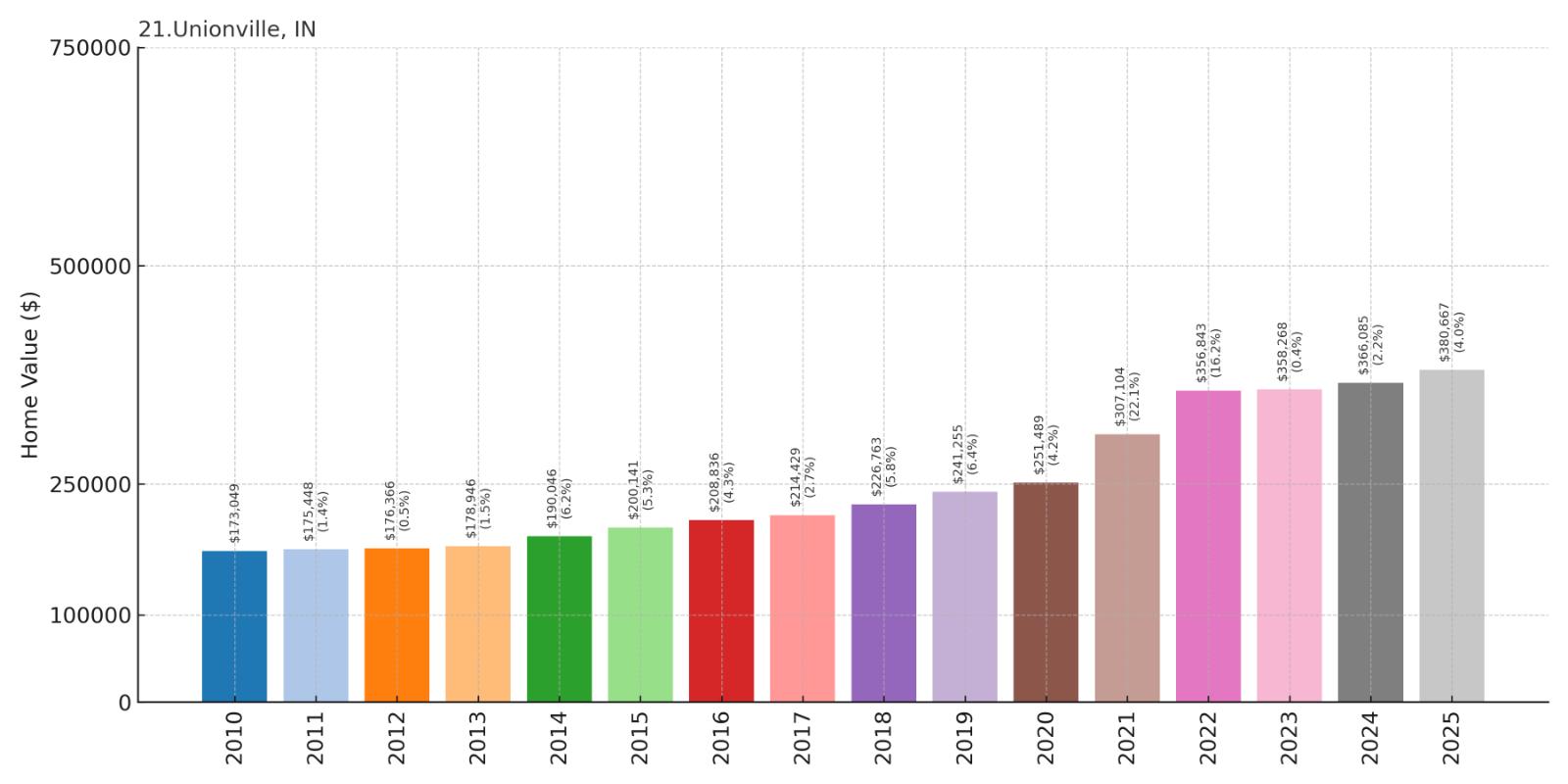
- 2010: $173,049
- 2011: $175,448
- 2012: $176,366
- 2013: $178,946
- 2014: $190,046
- 2015: $200,141
- 2016: $208,836
- 2017: $214,429
- 2018: $226,763
- 2019: $241,255
- 2020: $251,489
- 2021: $307,104
- 2022: $356,843
- 2023: $358,268
- 2024: $366,085
- 2025: $380,667
Unionville has achieved impressive 120% growth since 2010, reaching $380,667 in 2025. The Monroe County community experienced steady appreciation through the decade before dramatic acceleration during the pandemic years. Located near Indiana University, Unionville benefits from the stability of university-related demand.
Why Unionville?
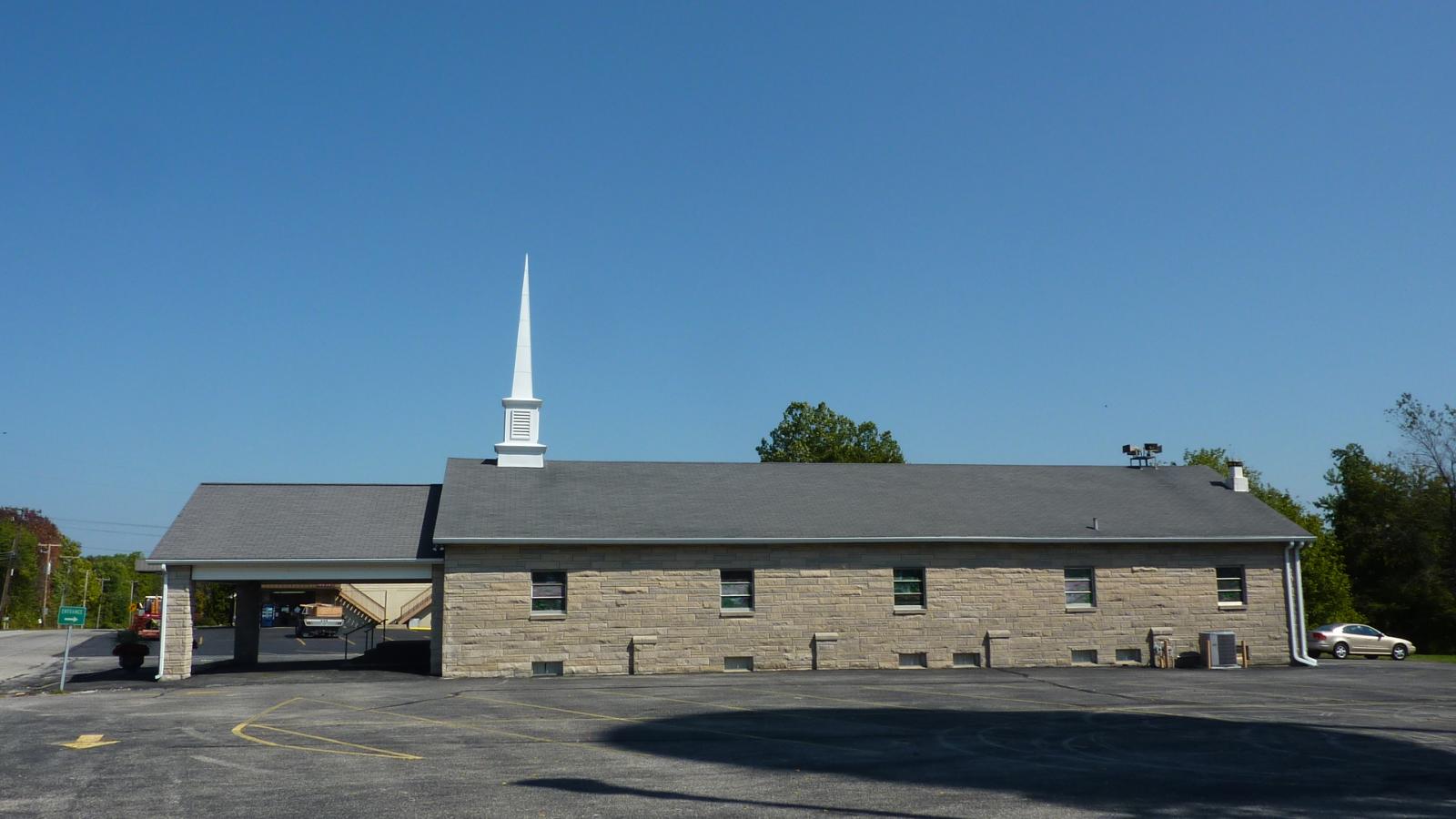
Why are people willing to pay so much to live here? What’s special about it?
Unionville appeals to buyers seeking rural tranquility near Indiana University, offering larger properties and scenic countryside settings. The area attracts university faculty, retirees, and professionals who appreciate the peaceful environment while maintaining access to Bloomington’s cultural amenities. The proximity to Indiana University provides stability and intellectual stimulation.
The community offers excellent outdoor recreation with nearby lakes, state forests, and hiking trails. Residents value the quiet, low-density lifestyle while staying connected to the university’s concerts, lectures, and cultural events just minutes away.
How Unionville Rose to Prominence
Unionville was established in the 1850s as a small farming community in southern Monroe County. The town remained primarily agricultural through most of the 20th century, serving local farms with basic services and a general store. The area’s character began changing in the 1960s as Indiana University faculty and staff sought rural properties within commuting distance of Bloomington.
The combination of scenic hills, wooded properties, and university proximity made Unionville increasingly attractive to educated professionals seeking a rural lifestyle. Lake Monroe’s development as a recreational destination in the 1960s added to the area’s appeal. Recent decades have seen growth in custom homes and small developments as remote work capabilities have made the rural setting even more desirable.
3 Interesting Tidbits
- University Connection – Many Unionville residents are Indiana University faculty, staff, or retirees who chose the area for its academic community and natural beauty.
- Lake Access – The town is near Lake Monroe, Indiana’s largest lake, providing excellent fishing, boating, and water recreation opportunities.
- Historic Charm – Unionville maintains its historic general store and rural character, creating an authentic small-town atmosphere just outside a major university city.
20. Noblesville – 114% Home Price Increase Since 2010

- 2010: $181,190
- 2011: $174,966
- 2012: $177,680
- 2013: $183,785
- 2014: $194,417
- 2015: $203,100
- 2016: $212,598
- 2017: $222,148
- 2018: $238,045
- 2019: $249,810
- 2020: $264,898
- 2021: $313,684
- 2022: $367,817
- 2023: $374,763
- 2024: $380,891
- 2025: $387,381
Noblesville has more than doubled since 2010, reaching $387,381 in 2025 with particularly strong growth during the pandemic. The Hamilton County seat combines historic charm with modern amenities, benefiting from excellent schools and proximity to Indianapolis. Downtown revitalization has enhanced the city’s appeal to families and young professionals.
Why Noblesville?
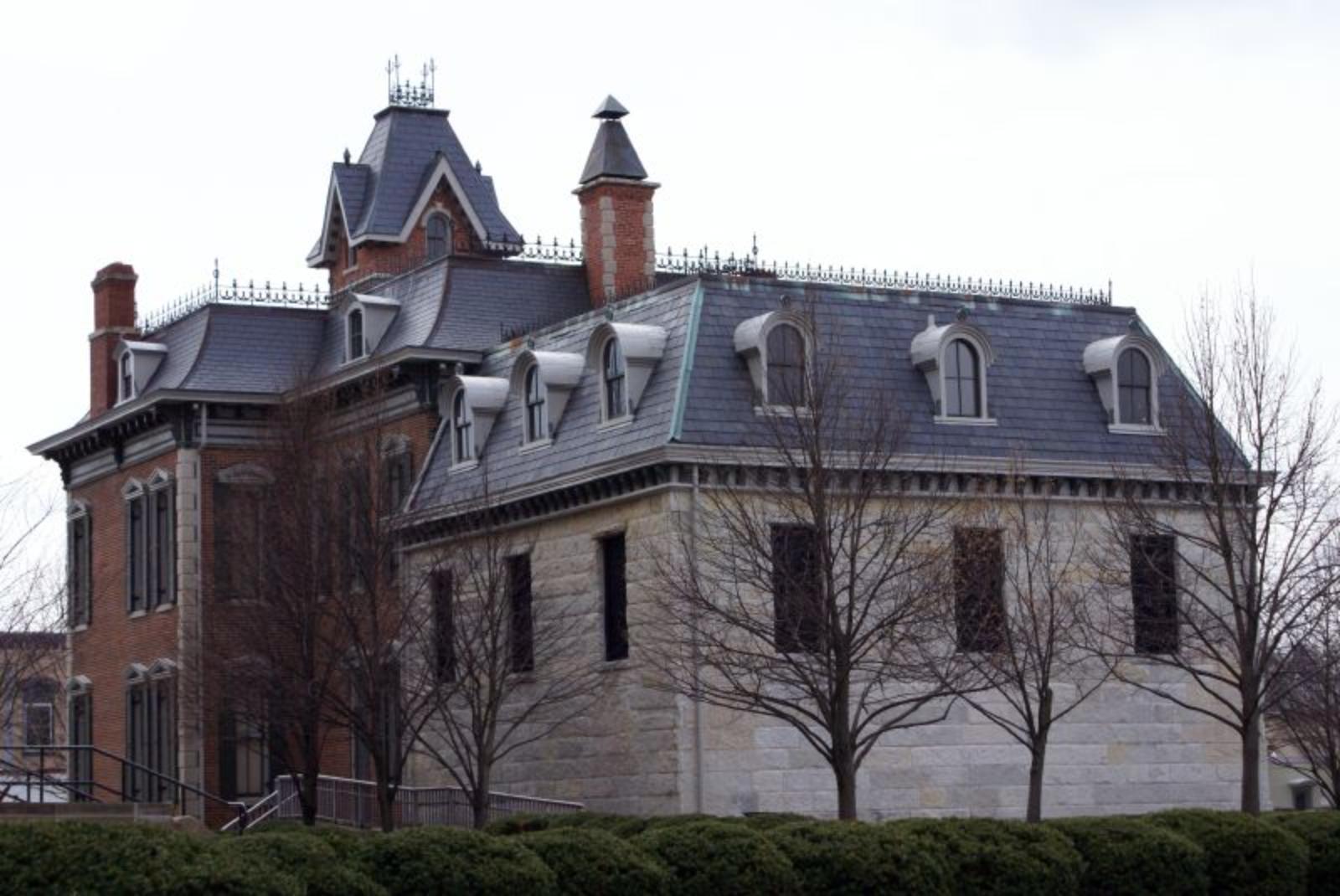
Why are people willing to pay so much to live here? What’s special about it?
Noblesville offers a perfect blend of historic downtown charm and modern suburban amenities, featuring a revitalized town square with restaurants, shops, and entertainment venues. The Noblesville Schools system consistently ranks among Indiana’s best, making it highly attractive to families. The city provides easy access to Indianapolis while maintaining its own identity and community feel.
Residents appreciate the numerous parks, trails, and recreational facilities, including the popular Morse Beach on Morse Reservoir. The combination of excellent schools, cultural activities, and outdoor recreation creates strong demand from families seeking a high quality of life.
How Noblesville Rose to Prominence
Founded in 1823 and named after early settler William Noble, Noblesville became the Hamilton County seat in 1824. The city developed as a commercial center for the surrounding agricultural region, with the arrival of railroads in the 1850s boosting growth. The White River provided water power for early mills and factories, establishing an industrial base alongside agriculture.
Modern growth accelerated in the 1960s as Indianapolis suburbs expanded northward. Noblesville’s combination of historic character, good schools, and county government stability made it attractive to families and businesses. The 1960s construction of Morse Reservoir created recreational opportunities that enhanced the area’s appeal. Recent downtown revitalization projects have transformed Noblesville into a vibrant destination while preserving its historic charm.
3 Interesting Tidbits
- County Seat – As Hamilton County’s seat of government since 1824, Noblesville has maintained political and economic importance throughout its history.
- Reservoir Recreation – Morse Reservoir, created in the 1960s, provides boating, swimming, and water sports just minutes from downtown.
- Historic Square – The beautifully restored downtown square features the 1879 courthouse and hosts numerous festivals and events throughout the year.
19. Needham – 157% Home Price Increase Since 2010
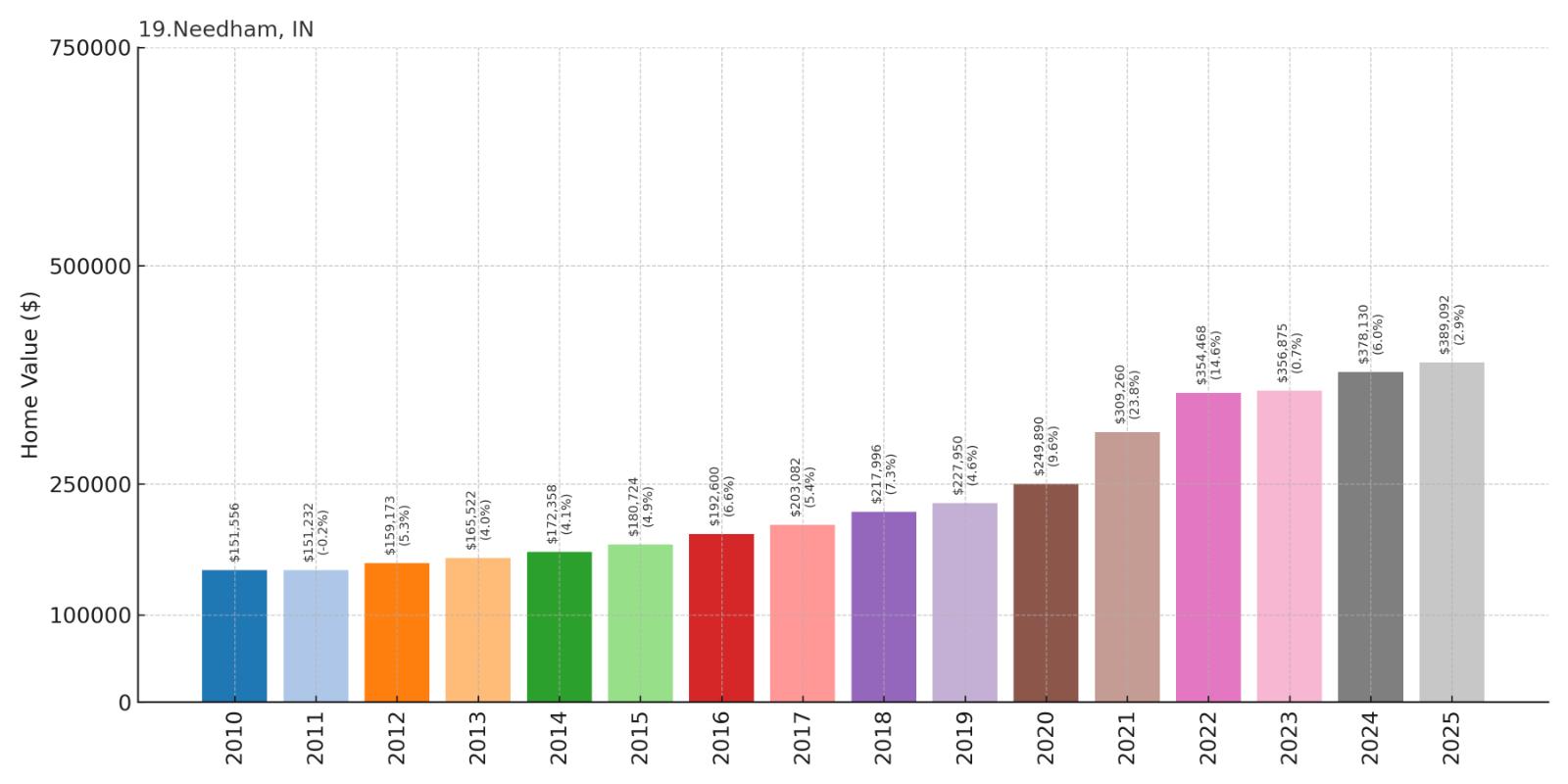
- 2010: $151,556
- 2011: $151,232
- 2012: $159,173
- 2013: $165,522
- 2014: $172,358
- 2015: $180,724
- 2016: $192,600
- 2017: $203,082
- 2018: $217,996
- 2019: $227,950
- 2020: $249,890
- 2021: $309,260
- 2022: $354,468
- 2023: $356,875
- 2024: $378,130
- 2025: $389,092
Needham has delivered exceptional returns with 157% growth since 2010, making it one of Indiana’s fastest-appreciating markets at $389,092. The Johnson County community experienced remarkable acceleration during the pandemic years, with values jumping over 55% between 2020 and 2022. This growth reflects strong demand in the Indianapolis metro area.
Why Needham?
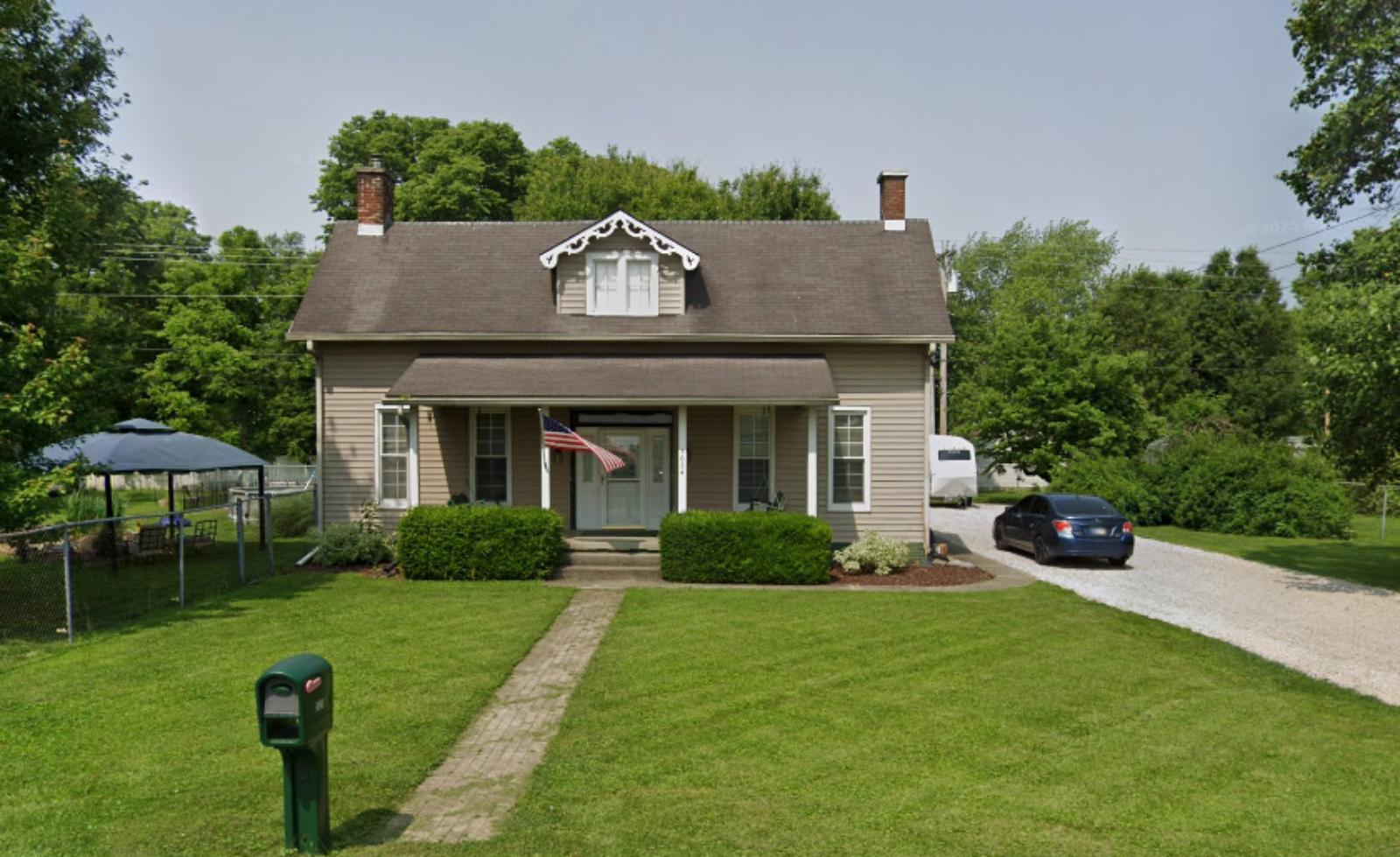
Why are people willing to pay so much to live here? What’s special about it?
Needham attracts buyers seeking affordable entry into the Indianapolis metro market while accessing quality schools and suburban amenities. The community offers newer housing developments with modern features at prices more reasonable than northern suburbs. Families appreciate the Johnson County location with easy access to employment centers throughout the metro area.
The area provides a suburban lifestyle with parks, trails, and community facilities while maintaining reasonable commutes to Indianapolis, Greenwood, and other employment hubs. The combination of affordability and convenience has created exceptionally strong demand and price appreciation.
How Needham Rose to Prominence
Needham developed as a small farming community in Johnson County during the late 19th century. The area remained primarily agricultural through most of the 20th century, with scattered farms and rural residences. Growth began in the 1990s as Indianapolis suburbs expanded southward and families sought affordable alternatives to more expensive areas.
The community’s transformation accelerated in the 2000s with new residential developments targeting first-time homebuyers and young families. Needham’s location between Indianapolis and growing southern suburbs like Greenwood made it attractive to commuters. The area’s relatively affordable land prices allowed for significant development while maintaining the suburban character that attracted residents.
3 Interesting Tidbits
- Rapid Appreciation – Needham has posted the highest home price appreciation rate among Indiana’s expensive communities, nearly tripling in value since 2010.
- Strategic Location – The community’s position in Johnson County provides access to employment throughout the Indianapolis metro area via major highways.
- Growth Magnet – Needham has attracted significant new residential development, transforming from rural farmland to a thriving suburban community in just two decades.
18. Floyds Knobs – 94% Home Price Increase Since 2010
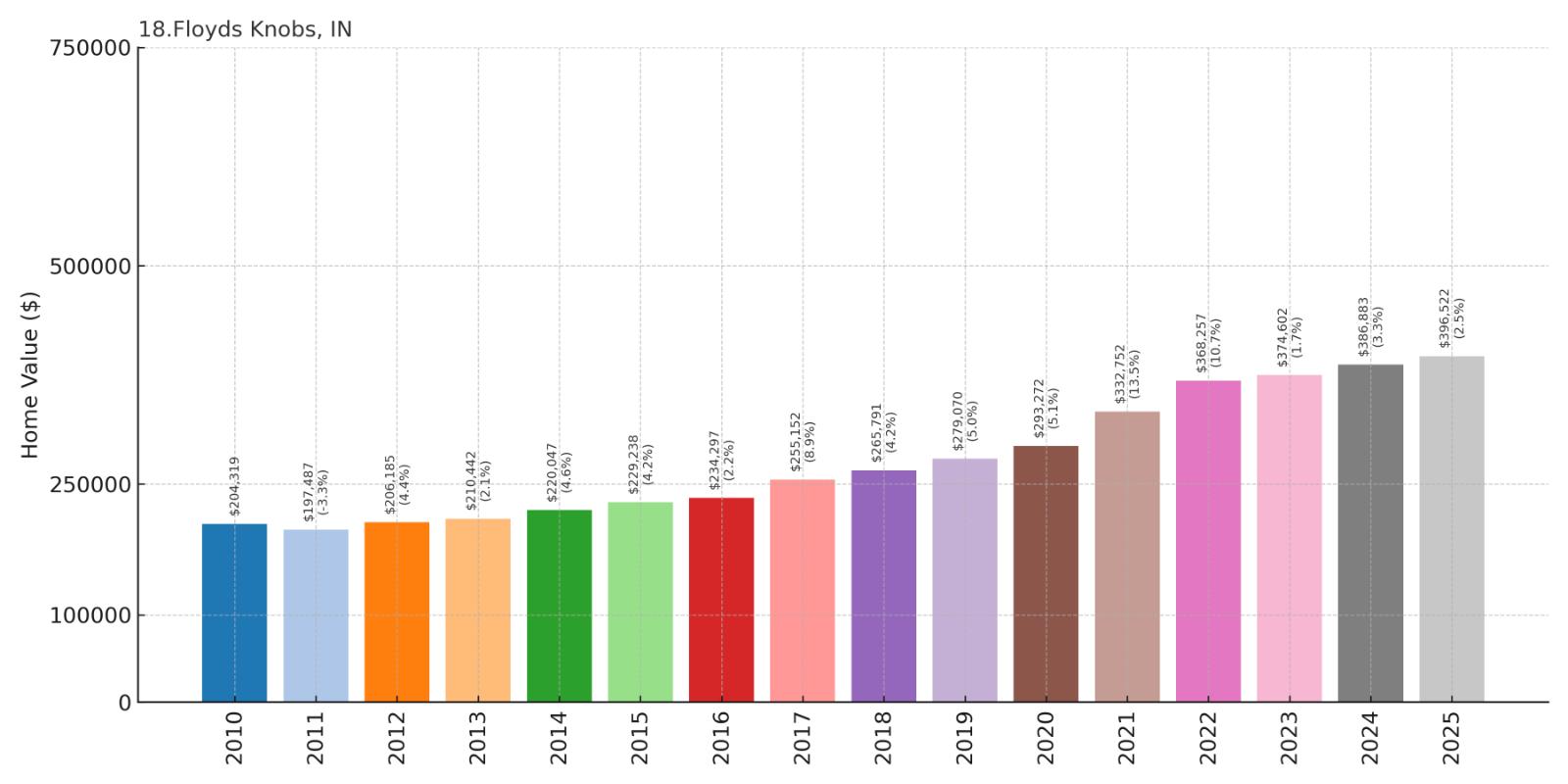
- 2010: $204,319
- 2011: $197,487
- 2012: $206,185
- 2013: $210,442
- 2014: $220,047
- 2015: $229,238
- 2016: $234,297
- 2017: $255,152
- 2018: $265,791
- 2019: $279,070
- 2020: $293,272
- 2021: $332,752
- 2022: $368,257
- 2023: $374,602
- 2024: $386,883
- 2025: $396,522
Floyds Knobs has nearly doubled since 2010, reaching $396,522 in 2025 with steady appreciation throughout the period. The Floyd County community started from a higher baseline than many towns on this list, reflecting its established desirability in southern Indiana. The town benefits from proximity to Louisville while maintaining small-town character.
Why Floyds Knobs?

Why are people willing to pay so much to live here? What’s special about it?
Floyds Knobs attracts residents with its scenic location in the rolling hills of southern Indiana, offering larger lots and custom homes in a peaceful setting. The community provides easy access to Louisville employment while maintaining Indiana’s lower cost of living and taxes. The New Albany-Floyd County school system and safe neighborhoods appeal to families.
The area features beautiful countryside, parks, and outdoor recreation opportunities while staying connected to Louisville’s urban amenities. Residents appreciate the combination of rural beauty and metropolitan access, creating strong demand for this unique location.
How Floyds Knobs Rose to Prominence
Floyds Knobs was named for the prominent hills (knobs) in the area and the Floyd family, early settlers in southern Indiana. The community developed slowly through the 19th and early 20th centuries as a rural area with scattered farms and small settlements. Its proximity to New Albany and the Ohio River provided some commercial connections, but the area remained largely agricultural.
Growth accelerated in the 1960s and 1970s as Louisville’s suburban expansion crossed the Ohio River into southern Indiana. The area’s scenic hills, larger lots, and lower costs attracted families and retirees seeking a quieter lifestyle with urban access. The completion of Interstate 265 improved connections to Louisville, making Floyds Knobs an increasingly attractive suburban alternative for Kentucky workers.
3 Interesting Tidbits
- Hill Country – Floyds Knobs sits in the scenic Indiana Knobstone region, featuring rolling hills and forested areas uncommon in much of Indiana.
- Louisville Access – Despite being in Indiana, many residents commute to Louisville, taking advantage of cross-border employment opportunities.
- Established Community – Unlike many towns on this list, Floyds Knobs was already relatively expensive in 2010, reflecting its long-standing desirability.
17. Topeka – 119% Home Price Increase Since 2010
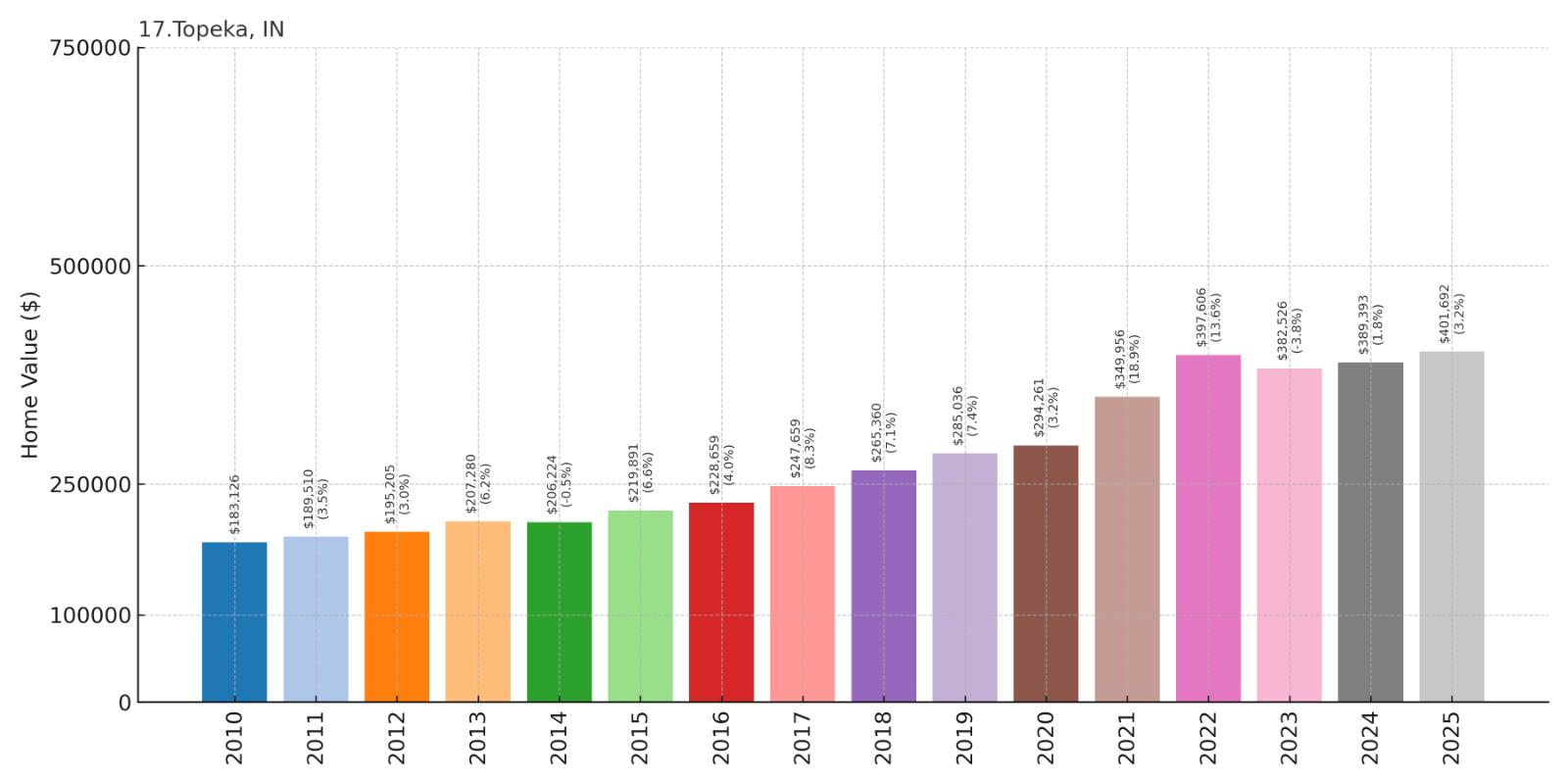
- 2010: $183,126
- 2011: $189,510
- 2012: $195,205
- 2013: $207,280
- 2014: $206,224
- 2015: $219,891
- 2016: $228,659
- 2017: $247,659
- 2018: $265,360
- 2019: $285,036
- 2020: $294,261
- 2021: $349,956
- 2022: $397,606
- 2023: $382,526
- 2024: $389,393
- 2025: $401,692
Topeka has more than doubled since 2010, reaching $401,692 in 2025 with particularly strong growth during the pandemic years. The LaGrange County town experienced steady appreciation through the 2010s before dramatic acceleration in 2021-2022. Located in Indiana’s Amish country, Topeka offers unique cultural experiences and rural charm.
Why Topeka?
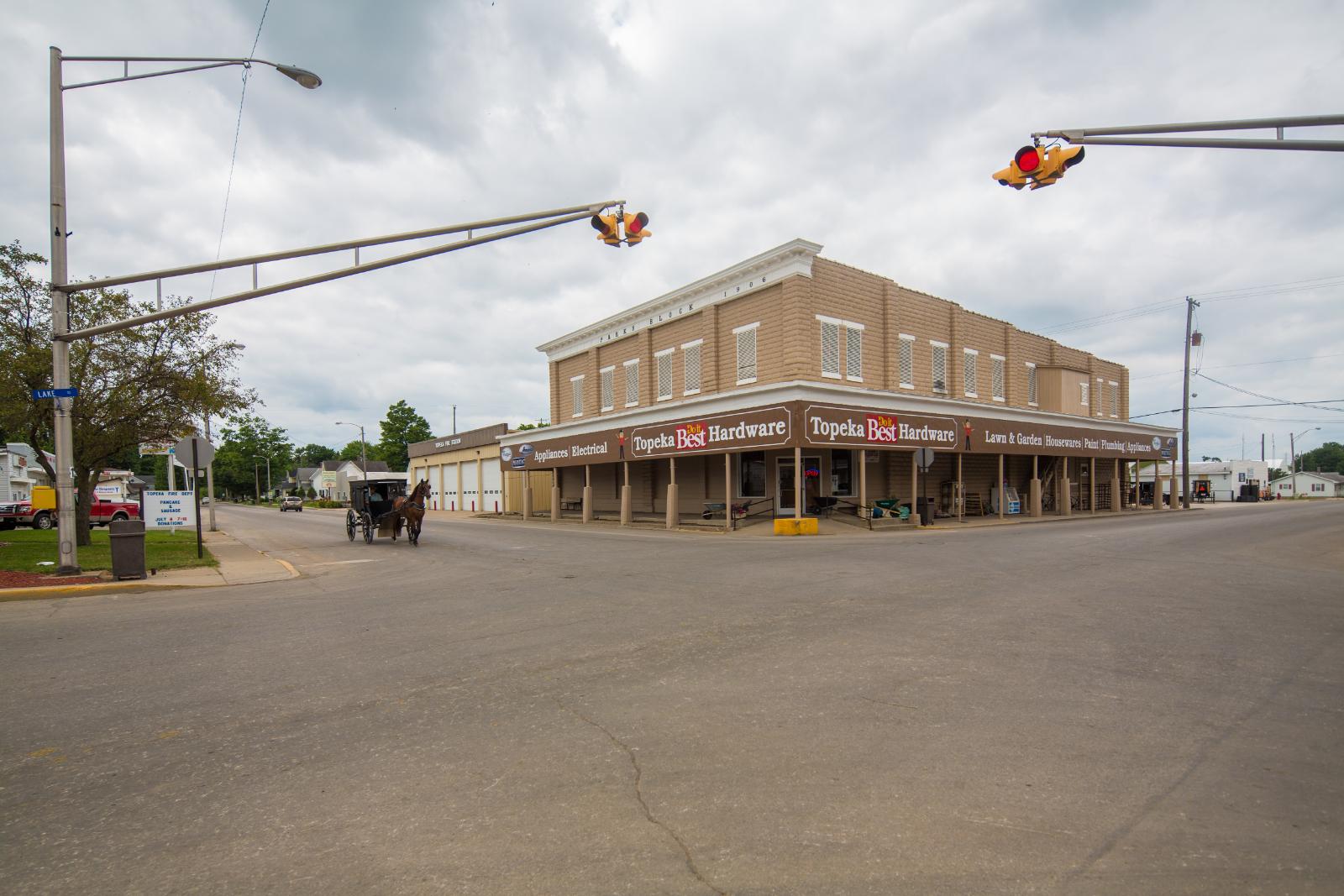
Why are people willing to pay so much to live here? What’s special about it?
Topeka provides authentic Amish country living with access to traditional craftsmanship, fresh farm produce, and a peaceful rural lifestyle. The community attracts buyers seeking larger properties, custom-built homes, and escape from urban pressures. The area’s reputation for quality construction and traditional values appeals to families and retirees.
Residents appreciate the scenic countryside, outdoor recreation opportunities, and strong sense of community. The combination of Amish heritage, rural beauty, and modern conveniences creates a unique living environment that commands premium prices.
How Topeka Rose to Prominence
Topeka was established in the 1830s by early settlers in LaGrange County. The town developed as a small commercial center serving surrounding farms, with the arrival of Amish and Mennonite families in the early 20th century significantly shaping its character. These communities brought traditional farming methods, craftsmanship skills, and strong work ethics that became hallmarks of the area.
The town’s modern desirability grew from its authentic rural character and the tourism industry that developed around Amish culture. Visitors attracted by furniture shops, bakeries, and traditional crafts began purchasing vacation homes and eventually relocating permanently. The area’s reputation for quality construction, peaceful lifestyle, and scenic beauty has made it increasingly attractive to buyers seeking an alternative to suburban developments.
3 Interesting Tidbits
- Amish Heritage – Topeka sits in the heart of one of Indiana’s largest Amish communities, where traditional craftsmanship and farming methods are still practiced daily.
- Tourism Economy – The town benefits from significant tourism related to Amish culture, antique shops, and rural attractions that bring thousands of visitors annually.
- Craft Tradition – The area is renowned for high-quality furniture, quilts, and other handcrafted items that attract buyers from across the region.
16. Cicero – 124% Home Price Increase Since 2010
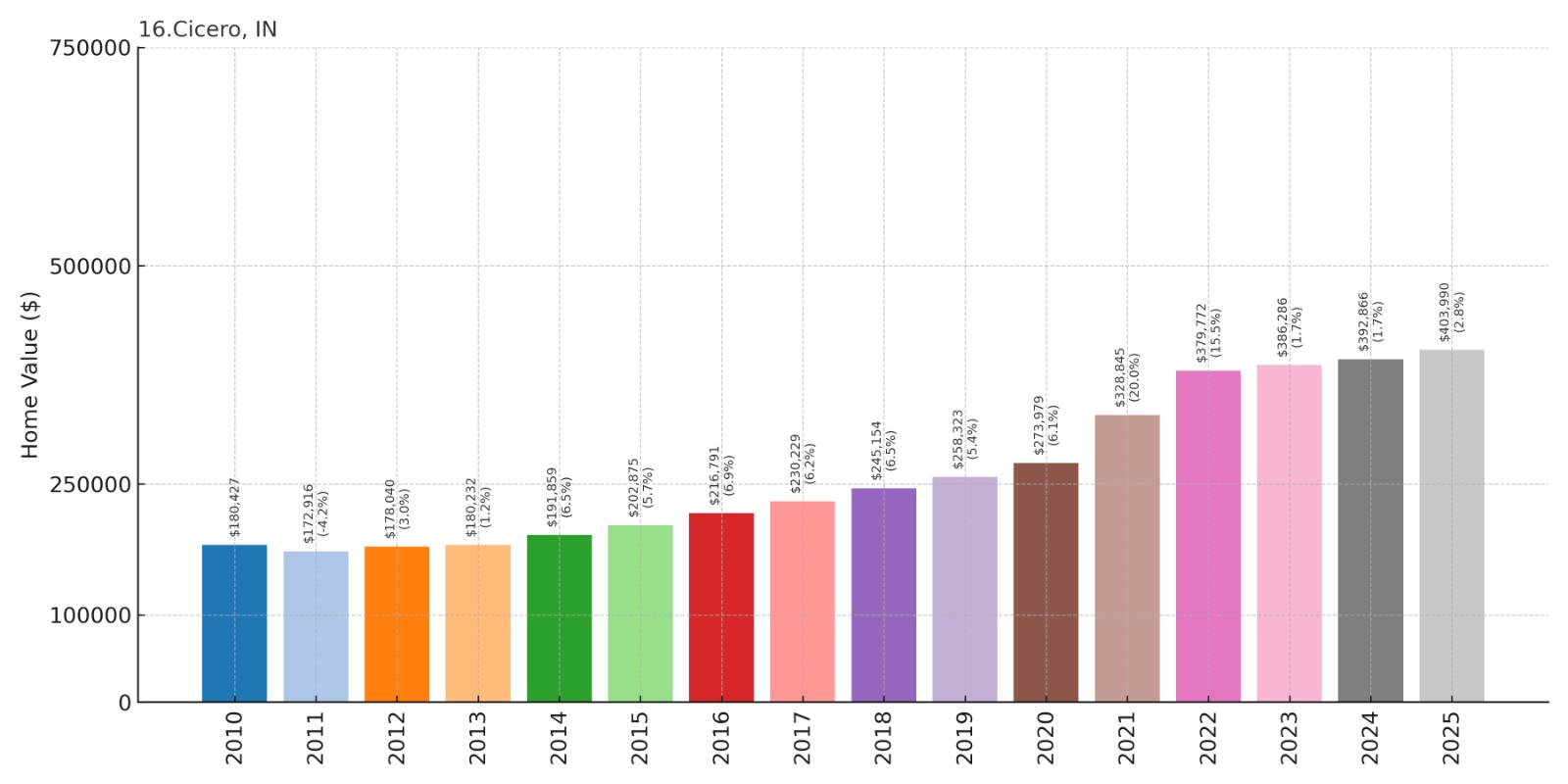
- 2010: $180,427
- 2011: $172,916
- 2012: $178,040
- 2013: $180,232
- 2014: $191,859
- 2015: $202,875
- 2016: $216,791
- 2017: $230,229
- 2018: $245,154
- 2019: $258,323
- 2020: $273,979
- 2021: $328,845
- 2022: $379,772
- 2023: $386,286
- 2024: $392,866
- 2025: $403,990
Cicero has achieved outstanding 124% growth since 2010, reaching $403,990 in 2025 with consistent appreciation throughout the period. The Hamilton County lakefront community showed steady gains through the 2010s before accelerating during the pandemic. Located on Morse Reservoir, Cicero combines waterfront living with proximity to Indianapolis.
Why Cicero?

Why are people willing to pay so much to live here? What’s special about it?
Cicero offers premier lakefront living on Morse Reservoir, providing boating, swimming, and water sports opportunities rare in central Indiana. The community features a mix of waterfront estates and family neighborhoods with beach access and marina facilities. Hamilton Southeastern Schools rank among Indiana’s best, making the area highly desirable for families.
The combination of lake lifestyle and excellent schools creates exceptional demand, particularly during summer months when the water activities are at their peak. Residents enjoy a resort-like atmosphere while maintaining easy access to Indianapolis employment and shopping.
How Cicero Rose to Prominence
Cicero was founded in 1834 along the White River, named after the famous Roman orator. The town served as a shipping point for agricultural products throughout the 19th century, with mills and grain elevators supporting the local economy. The community remained primarily agricultural until the creation of Morse Reservoir in the 1960s transformed it into a recreational destination.
The reservoir’s construction for Indianapolis water supply created one of central Indiana’s most desirable recreational areas. Property values began rising as waterfront lots became available for development. The combination of excellent schools, lake access, and proximity to growing Hamilton County employment centers made Cicero increasingly attractive to affluent families. Recent decades have seen significant development of upscale neighborhoods and luxury waterfront homes.
3 Interesting Tidbits
- Reservoir Living – Morse Reservoir covers 1,500 acres and provides some of central Indiana’s best recreational boating and swimming opportunities.
- Beach Town Feel – Cicero maintains several public beaches and a marina, creating a unique lakeside atmosphere unusual for inland Indiana.
- Summer Destination – Many Indianapolis-area families own vacation homes in Cicero, boosting demand for waterfront properties.
15. Millersburg – 146% Home Price Increase Since 2010
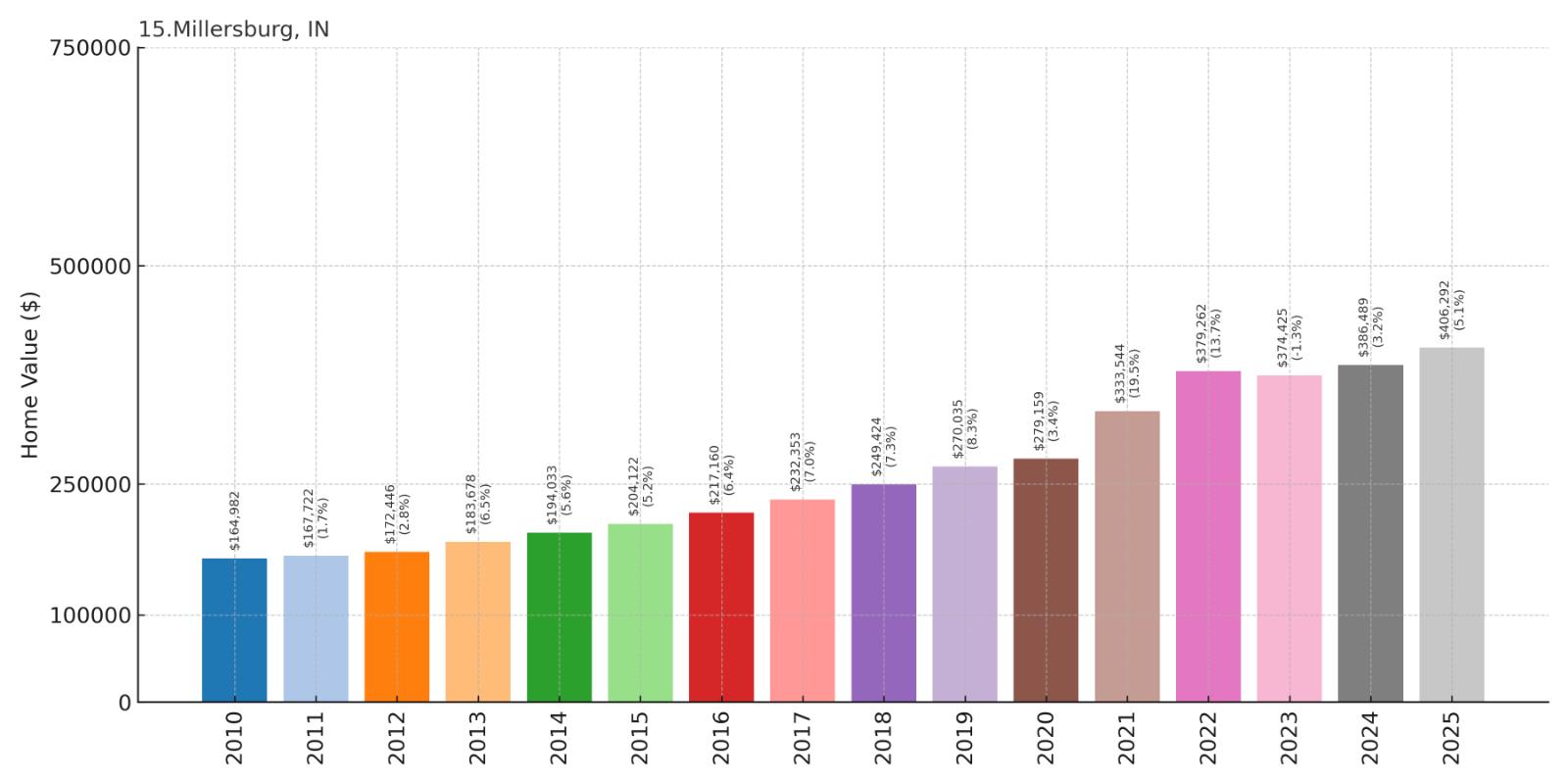
- 2010: $164,982
- 2011: $167,722
- 2012: $172,446
- 2013: $183,678
- 2014: $194,033
- 2015: $204,122
- 2016: $217,160
- 2017: $232,353
- 2018: $249,424
- 2019: $270,035
- 2020: $279,159
- 2021: $333,544
- 2022: $379,262
- 2023: $374,425
- 2024: $386,489
- 2025: $406,292
Millersburg has posted remarkable 146% growth since 2010, reaching $406,292 in 2025 with exceptional appreciation throughout the period. The Elkhart County town experienced particularly strong growth during the pandemic years when values jumped nearly 45%. Located in the heart of RV manufacturing country, Millersburg benefits from regional economic strength.
Why Millersburg?

Why are people willing to pay so much to live here? What’s special about it?
Millersburg attracts residents with its location in the heart of Indiana’s RV manufacturing region, providing stable employment opportunities and economic growth. The community offers small-town charm with Amish cultural influences, including access to quality craftsmanship and traditional foods. The area features excellent schools and safe neighborhoods appealing to families.
The combination of strong manufacturing jobs, rural beauty, and cultural richness creates unique appeal. Residents appreciate the peaceful lifestyle while having access to good-paying careers in the thriving RV industry that has made Elkhart County famous worldwide.
How Millersburg Rose to Prominence
Millersburg was founded in the 1850s in Elkhart County, developing as a small farming community. The town remained primarily agricultural through the early 20th century, with grain elevators and farm supply stores serving the surrounding rural area. The arrival of Amish and Mennonite families brought traditional farming methods and craftsmanship that became characteristic of the region.
The town’s transformation began in the post-World War II era with the growth of the recreational vehicle industry in Elkhart County. Major manufacturers like Forest River, Keystone, and others established operations nearby, creating thousands of jobs and attracting workers to the area. Millersburg’s small-town character, combined with proximity to these employment centers, made it an attractive place for workers to settle and raise families. The area’s reputation for quality construction and peaceful living has continued to draw residents seeking alternatives to urban areas.
3 Interesting Tidbits
- RV Capital Proximity – Millersburg sits near the center of Elkhart County, which produces about 80% of America’s recreational vehicles.
- Amish Craftsmanship – The town benefits from its location in Amish country, where traditional woodworking and construction skills are still practiced.
- Economic Stability – The RV industry’s success has provided economic stability and good-paying jobs that support higher property values throughout the region.
14. Granger – 96% Home Price Increase Since 2010

- 2010: $208,200
- 2011: $205,567
- 2012: $202,379
- 2013: $210,751
- 2014: $216,722
- 2015: $221,470
- 2016: $233,902
- 2017: $248,271
- 2018: $261,162
- 2019: $272,546
- 2020: $282,288
- 2021: $328,783
- 2022: $373,056
- 2023: $381,141
- 2024: $391,296
- 2025: $408,434
Granger has nearly doubled since 2010, reaching $408,434 in 2025 with steady appreciation throughout the period. The St. Joseph County community started from a higher baseline, reflecting its established position as an upscale South Bend suburb. The town benefits from proximity to the University of Notre Dame and strong local economy.
Why Granger?
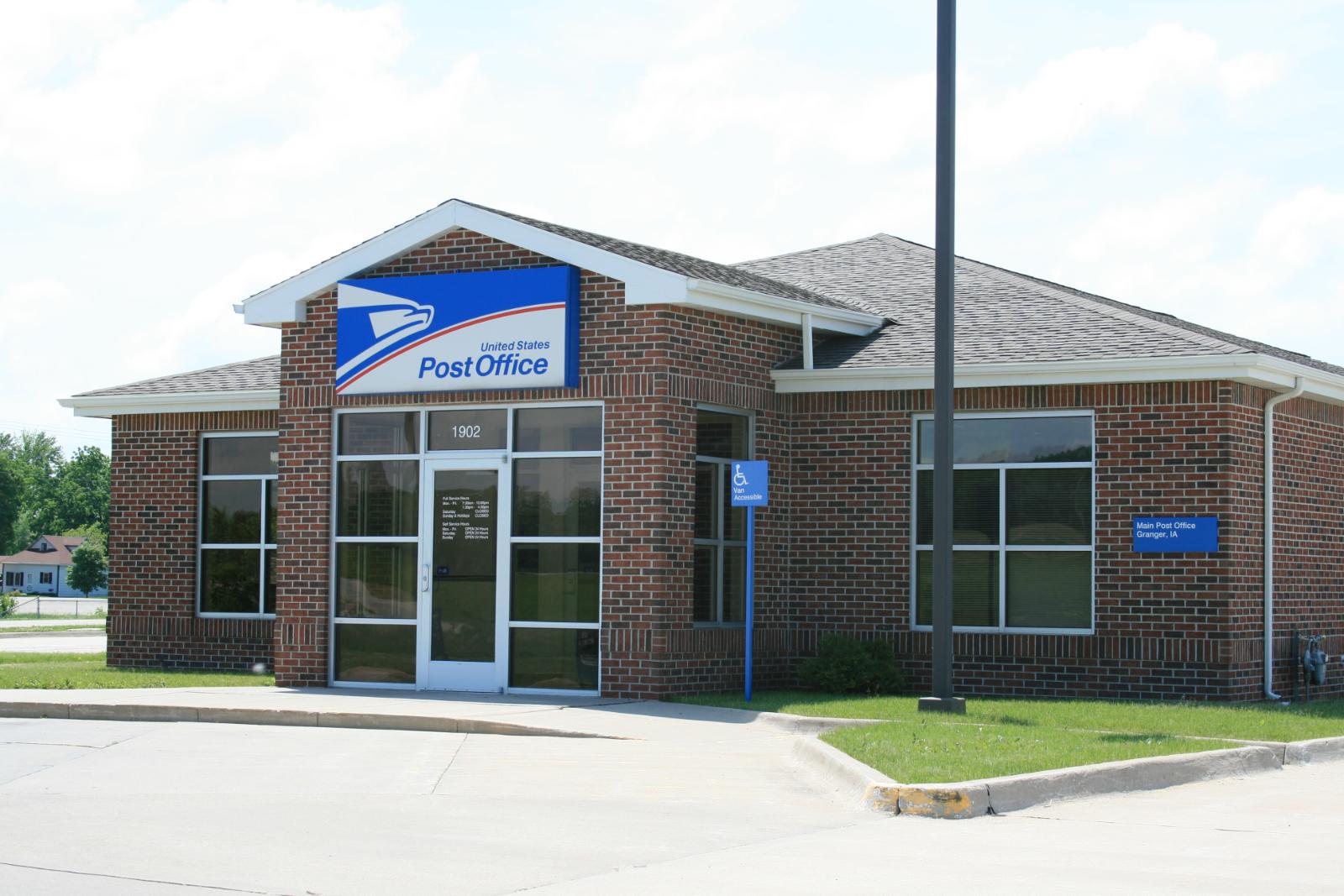
Why are people willing to pay so much to live here? What’s special about it?
Granger attracts affluent families with its upscale neighborhoods, excellent schools, and proximity to the University of Notre Dame. The community features luxury shopping at University Park Mall, fine dining, and cultural amenities rare in smaller Indiana towns. The Penn-Harris-Madison school system consistently ranks among the state’s best.
The area provides a sophisticated suburban lifestyle with easy access to Notre Dame athletics, cultural events, and academic opportunities. Residents appreciate the combination of educational excellence, cultural richness, and economic stability that makes Granger one of northern Indiana’s premier communities.
How Granger Rose to Prominence
Granger developed as a farming community in St. Joseph County during the mid-19th century. The area remained primarily agricultural until the 20th century, when South Bend’s industrial growth began attracting residents seeking suburban alternatives. The proximity to the University of Notre Dame, founded in 1842, provided cultural and educational amenities that enhanced the area’s appeal.
Significant growth began in the 1960s and 1970s as South Bend expanded and higher-income residents sought newer housing options. The development of University Park Mall in the 1980s established Granger as a regional shopping and dining destination. The area’s combination of excellent schools, upscale amenities, and Notre Dame proximity has made it consistently attractive to professionals, university faculty, and business executives throughout northern Indiana and southern Michigan.
3 Interesting Tidbits
- Notre Dame Connection – Granger’s proximity to the University of Notre Dame provides residents access to world-class athletics, concerts, and cultural events.
- Shopping Destination – University Park Mall and surrounding retail developments make Granger a regional shopping hub for northern Indiana and southern Michigan.
- Executive Community – The area attracts business executives and professionals from throughout the region, creating one of Indiana’s most affluent suburban communities.
13. Guilford – 122% Home Price Increase Since 2010

- 2010: $186,565
- 2011: $184,970
- 2012: $185,945
- 2013: $189,341
- 2014: $194,736
- 2015: $204,854
- 2016: $218,996
- 2017: $231,185
- 2018: $240,172
- 2019: $251,838
- 2020: $274,335
- 2021: $322,823
- 2022: $366,161
- 2023: $383,416
- 2024: $399,114
- 2025: $413,214
Guilford has achieved strong 122% growth since 2010, reaching $413,214 in 2025 with consistent appreciation accelerating during the pandemic years. The Hendricks County community benefits from its location in the rapidly growing western Indianapolis suburbs. The area offers newer developments with excellent access to employment centers.
Why Guilford?

Why are people willing to pay so much to live here? What’s special about it?
Guilford attracts families seeking newer housing in planned communities with modern amenities and excellent schools. The area provides easy access to Indianapolis International Airport and major employment centers along the I-70 corridor. The Plainfield Community School Corporation and safe neighborhoods create strong demand from families with children.
The community offers a suburban lifestyle with parks, trails, and recreational facilities while maintaining reasonable commutes to Indianapolis and surrounding employment hubs. Residents appreciate the newer construction, modern infrastructure, and family-friendly environment that characterizes the area.
How Guilford Rose to Prominence
Guilford developed as part of the western expansion of Indianapolis suburbs in Hendricks County. Originally farmland, the area began attracting residential development in the 1990s as families sought alternatives to more expensive Hamilton County communities. The proximity to Indianapolis International Airport and major transportation corridors made it attractive for development.
Growth accelerated in the 2000s with the establishment of planned neighborhoods and the expansion of employment centers along the I-70 corridor. The area’s location between Indianapolis and the airport created demand from aviation industry workers and frequent travelers. The combination of new construction, good schools, and convenient location has made Guilford one of the fastest-growing areas in Hendricks County.
3 Interesting Tidbits
- Airport Proximity – Guilford’s location near Indianapolis International Airport makes it popular with aviation industry employees and frequent travelers.
- Planned Growth – The community features carefully planned neighborhoods with modern amenities, parks, and community facilities.
- School Excellence – The Plainfield Community School Corporation consistently receives high ratings and attracts families throughout the western Indianapolis metro area.
12. Shadeland – 114% Home Price Increase Since 2010
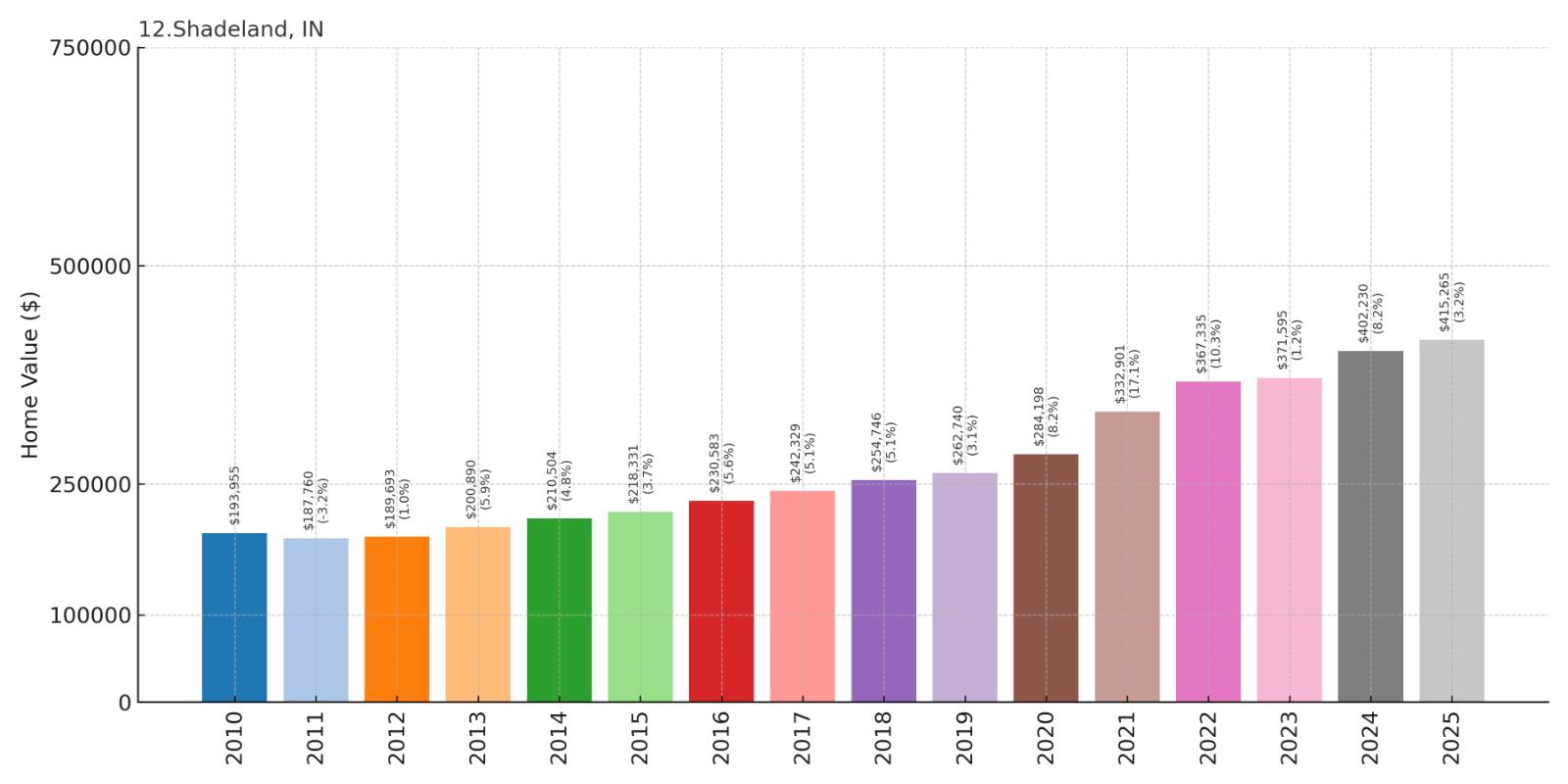
- 2010: $193,955
- 2011: $187,760
- 2012: $189,693
- 2013: $200,890
- 2014: $210,504
- 2015: $218,331
- 2016: $230,583
- 2017: $242,329
- 2018: $254,746
- 2019: $262,740
- 2020: $284,198
- 2021: $332,901
- 2022: $367,335
- 2023: $371,595
- 2024: $402,230
- 2025: $415,265
Shadeland has more than doubled since 2010, reaching $415,265 in 2025 with particularly strong growth in recent years. The Tippecanoe County community experienced steady appreciation through the 2010s before accelerating significantly during and after the pandemic. The area benefits from proximity to Lafayette and West Lafayette employment centers.
Why Shadeland?

Why are people willing to pay so much to live here? What’s special about it?
Shadeland attracts residents seeking a rural lifestyle with urban convenience, offering larger properties and newer construction near Lafayette-West Lafayette employment centers. The community provides easy access to Purdue University and regional employers while maintaining lower costs than urban areas. The Tippecanoe School Corporation and safe neighborhoods appeal to families.
The area offers outdoor recreation opportunities with nearby parks and the Wabash River while staying connected to the cultural and educational amenities of the Lafayette-West Lafayette area. Residents appreciate the peaceful setting and space for outdoor activities while maintaining reasonable commutes.
How Shadeland Rose to Prominence
Shadeland developed as a farming community in Tippecanoe County, remaining primarily agricultural through most of the 20th century. The area’s transformation began in the 1980s as Lafayette-West Lafayette expanded and housing demand increased. The proximity to Purdue University and major employers made it attractive for residential development.
Growth accelerated in the 2000s as the Lafayette area economy expanded and residents sought alternatives to urban living. The community’s location provided easy access to jobs while offering larger lots and newer construction. Recent development has focused on family-friendly neighborhoods that appeal to university faculty, professionals, and families seeking suburban amenities with rural character.
3 Interesting Tidbits
- University Access – Shadeland provides convenient access to Purdue University for faculty, staff, and students seeking off-campus housing.
- Rural Suburban – The community successfully balances rural character with suburban amenities, attracting residents seeking the best of both worlds.
- Growth Pattern – Shadeland has experienced some of Indiana’s most consistent home price appreciation, reflecting steady demand and limited supply.
11. Fishers – 103% Home Price Increase Since 2010
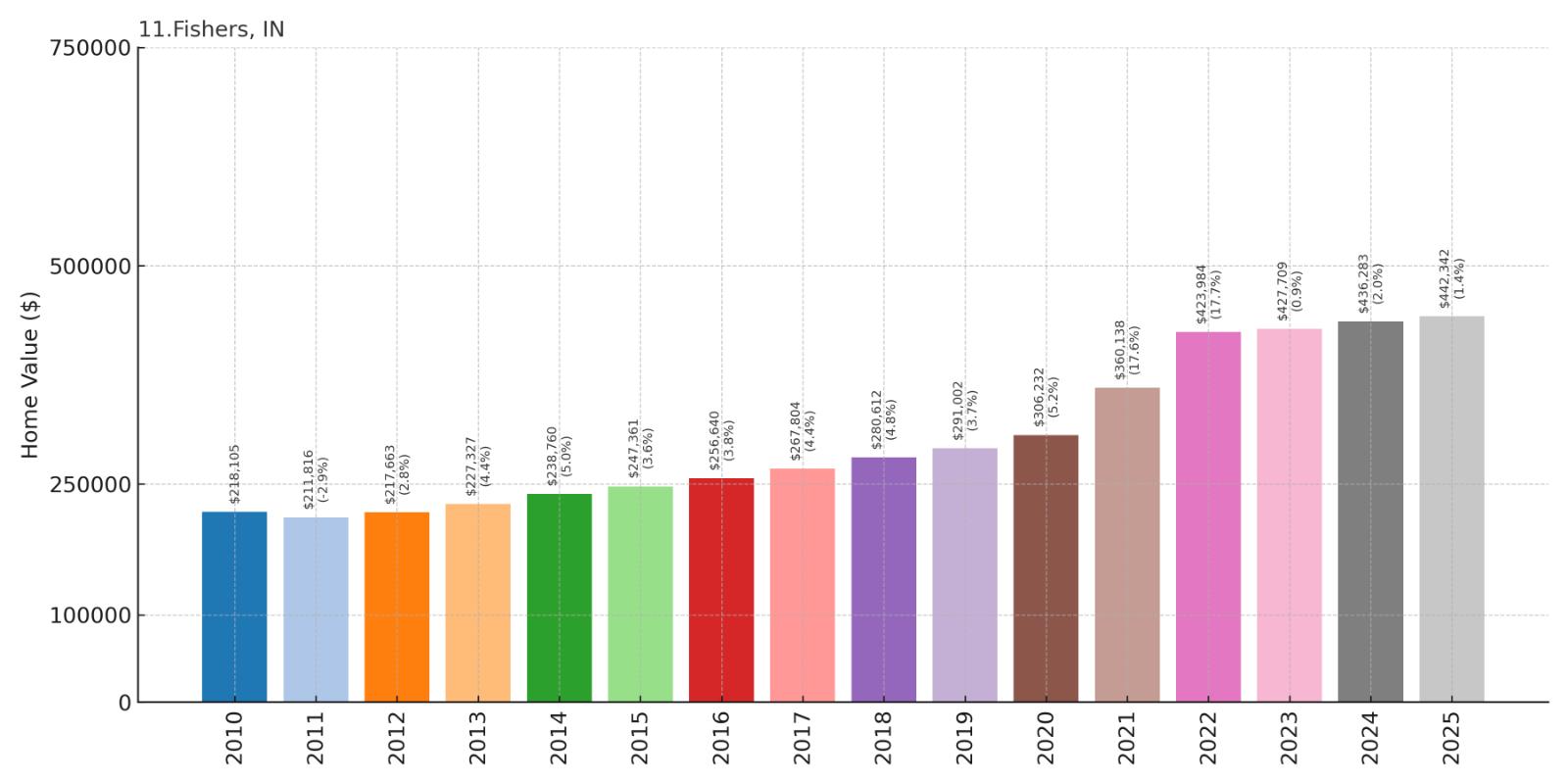
- 2010: $218,105
- 2011: $211,816
- 2012: $217,663
- 2013: $227,327
- 2014: $238,760
- 2015: $247,361
- 2016: $256,640
- 2017: $267,804
- 2018: $280,612
- 2019: $291,002
- 2020: $306,232
- 2021: $360,138
- 2022: $423,984
- 2023: $427,709
- 2024: $436,283
- 2025: $442,342
Fishers has more than doubled since 2010, reaching $442,342 in 2025 with steady growth throughout the period. The Hamilton County city experienced consistent appreciation through the 2010s before dramatic acceleration during the pandemic years. Fishers has transformed from a small town into one of Indiana’s most desirable suburban destinations.
Why Fishers?

Why are people willing to pay so much to live here? What’s special about it?
Fishers offers an exceptional combination of top-rated schools, modern amenities, and family-friendly neighborhoods that consistently rank among the best places to live in Indiana. The Hamilton Southeastern Schools system ranks among the state’s finest, while the city features numerous parks, trails, and recreational facilities. The downtown area has been completely redeveloped with restaurants, entertainment, and mixed-use developments.
The city provides easy access to Indianapolis employment while maintaining its own thriving business district and tech sector. Residents appreciate the high quality of life, excellent services, and strong sense of community that makes Fishers particularly attractive to young professionals and families.
How Fishers Rose to Prominence
Fishers was founded in 1872 as a small railroad town in Hamilton County, remaining largely agricultural through the mid-20th century. The town’s transformation began in the 1980s as Indianapolis suburbs expanded northward and developers recognized the area’s potential. The community’s location near major highways and good school system made it attractive for residential development.
Explosive growth occurred in the 1990s and 2000s as Fishers became synonymous with quality suburban living. The city incorporated in 2015, allowing for better planning and development control. Major investments in downtown redevelopment, the Nickel Plate District, and business attraction have transformed Fishers into a destination rather than just a bedroom community. The city’s focus on technology, entrepreneurship, and quality of life has made it one of Indiana’s most successful suburban communities.
3 Interesting Tidbits
- Startup Hub – Fishers has become a regional center for technology startups and entrepreneurship, with programs supporting innovation and business development.
- Downtown Transformation – The city completely redeveloped its downtown area, creating the Nickel Plate District with restaurants, apartments, and entertainment venues.
- National Recognition – Fishers consistently ranks among the best places to live in America, with recognition for schools, safety, and quality of life.
10. Bargersville – 119% Home Price Increase Since 2010

- 2010: $204,688
- 2011: $195,038
- 2012: $205,594
- 2013: $213,184
- 2014: $221,615
- 2015: $230,672
- 2016: $243,278
- 2017: $258,829
- 2018: $273,440
- 2019: $290,288
- 2020: $312,146
- 2021: $375,508
- 2022: $436,564
- 2023: $433,286
- 2024: $442,644
- 2025: $448,415
Bargersville has achieved remarkable 119% growth since 2010, reaching $448,415 in 2025 with exceptional acceleration during the pandemic years. The Johnson County community experienced steady growth through the 2010s before explosive appreciation when values jumped over 55% between 2020 and 2022. This growth reflects strong demand in the southern Indianapolis metro area.
Why Bargersville?

Why are people willing to pay so much to live here? What’s special about it?
Bargersville attracts families with its excellent Center Grove Community School Corporation, consistently ranked among Indiana’s best school systems. The town offers newer housing developments with modern amenities while maintaining a small-town atmosphere. Easy access to Indianapolis via I-69 provides convenient commutes to downtown employment centers.
The community features numerous parks, trails, and recreational facilities while preserving its historic downtown area. Residents appreciate the combination of top-tier education, safe neighborhoods, and family-friendly environment that has made Bargersville one of the most sought-after communities in Johnson County.
How Bargersville Rose to Prominence
Bargersville was founded in 1849 by John Barger, developing as a small farming community along the railroad line. The town remained primarily agricultural through most of the 20th century, with grain elevators and farm supply stores serving the surrounding rural area. Growth began in the 1980s as Indianapolis suburbs expanded southward and families discovered the excellent Center Grove schools.
The community’s transformation accelerated in the 1990s and 2000s as the Center Grove school system gained statewide recognition for academic and athletic excellence. New residential developments attracted families from throughout the Indianapolis metro area seeking access to these highly rated schools. The completion of I-69 improved access to downtown Indianapolis, making Bargersville an increasingly attractive suburban destination for professionals and families.
3 Interesting Tidbits
- School Excellence – The Center Grove Community School Corporation consistently ranks among Indiana’s top school systems, driving much of the area’s residential demand.
- Historic Downtown – Bargersville maintains its charming historic downtown district while accommodating significant suburban growth.
- Athletic Tradition – Center Grove High School is renowned for its successful athletic programs, particularly football, creating strong community pride and school spirit.
9. Saint John – 77% Home Price Increase Since 2010
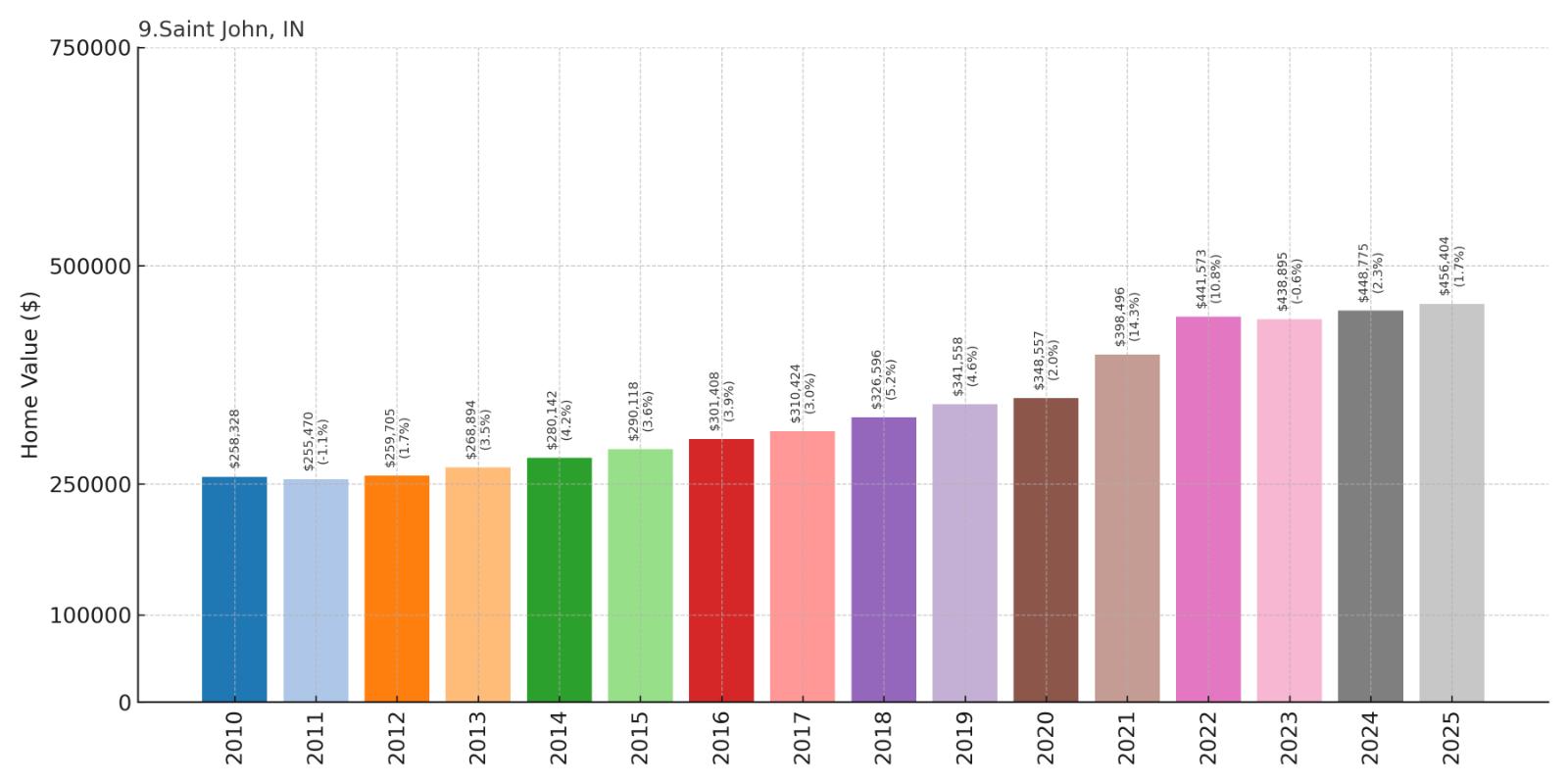
- 2010: $258,328
- 2011: $255,470
- 2012: $259,705
- 2013: $268,894
- 2014: $280,142
- 2015: $290,118
- 2016: $301,408
- 2017: $310,424
- 2018: $326,596
- 2019: $341,558
- 2020: $348,557
- 2021: $398,496
- 2022: $441,573
- 2023: $438,895
- 2024: $448,775
- 2025: $456,404
Saint John has grown 77% since 2010, reaching $456,404 in 2025 with steady appreciation throughout the period. The Lake County community started from a much higher baseline than most towns on this list, reflecting its established position as one of northwest Indiana’s premier suburbs. The town benefits from proximity to Chicago while maintaining Indiana’s lower costs and taxes.
Why Saint John?

Why are people willing to pay so much to live here? What’s special about it?
Saint John attracts Chicago-area professionals seeking high-quality suburban living with excellent schools at a fraction of Chicago metro costs. The Lake Central School Corporation ranks among Indiana’s finest, while the town offers upscale neighborhoods, parks, and recreational facilities. The location provides reasonable commutes to Chicago while enjoying Indiana’s lower taxes and cost of living.
The community features newer developments with larger lots and custom homes not typically available in Chicago suburbs at comparable prices. Residents appreciate the small-town atmosphere combined with big-city accessibility and the significant cost savings compared to Illinois communities.
How Saint John Rose to Prominence
Saint John was incorporated in 1911 as a small farming community in Lake County. The town remained primarily agricultural until the 1960s when suburban development began reaching south from the Chicago metro area. The extension of major highways and improved transportation links made Saint John accessible to Chicago-area employment while offering lower costs than Illinois suburbs.
Significant growth occurred in the 1980s and 1990s as Chicago professionals discovered the area’s combination of excellent schools, new housing, and substantial cost savings. The Lake Central school system’s reputation for excellence attracted families throughout the region. Saint John’s careful planning and development standards have maintained its character as an upscale suburban community while accommodating steady growth.
3 Interesting Tidbits
- Chicago Commuter Haven – Many Saint John residents commute to Chicago area jobs, taking advantage of Indiana’s lower costs and taxes.
- School District Draw – The Lake Central School Corporation’s excellent reputation attracts families from throughout northwest Indiana and even Illinois.
- Established Affluence – Saint John was already relatively expensive in 2010, reflecting its long-standing status as one of the region’s most desirable communities.
8. Westfield – 105% Home Price Increase Since 2010
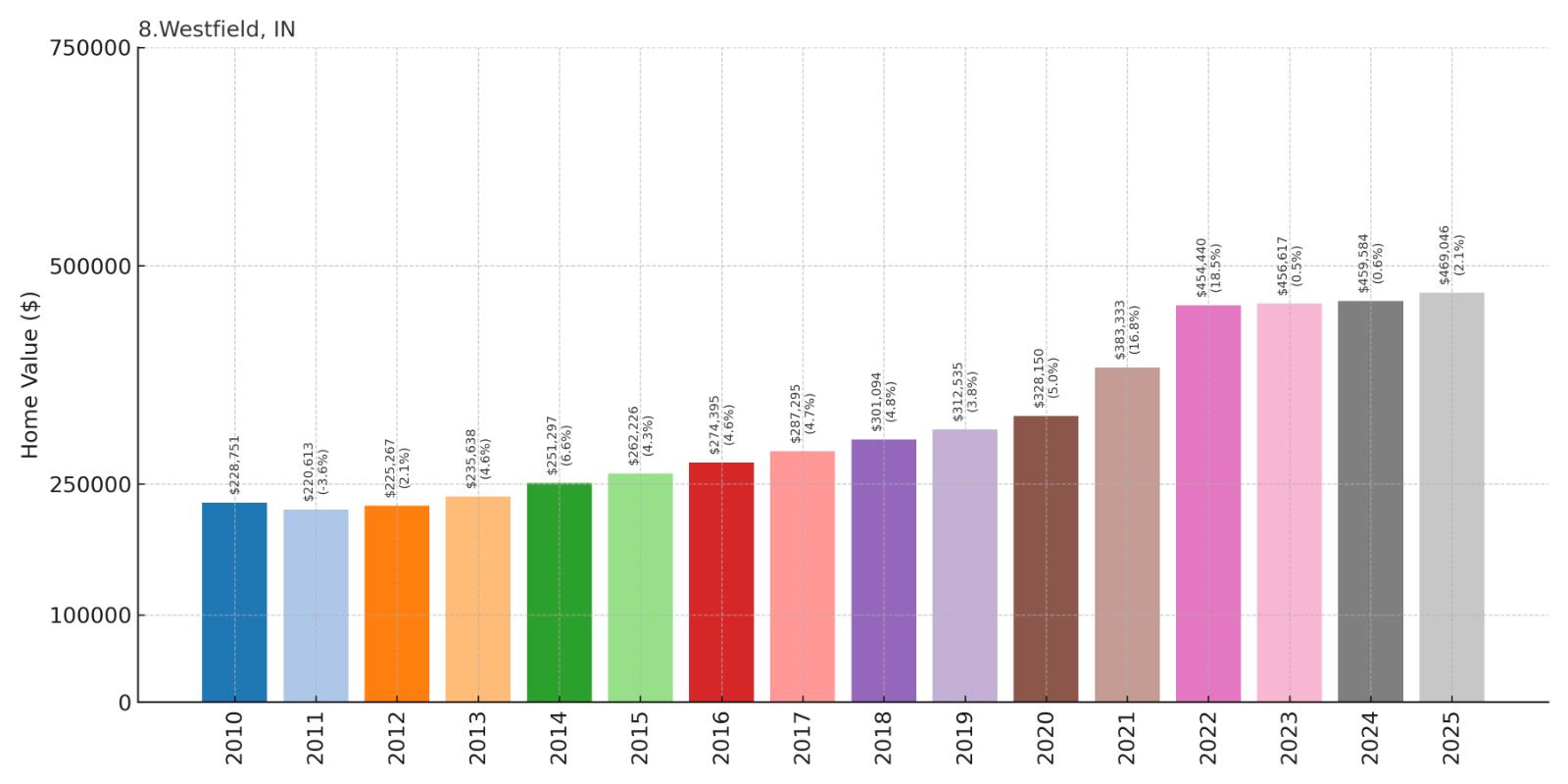
- 2010: $228,751
- 2011: $220,613
- 2012: $225,267
- 2013: $235,638
- 2014: $251,297
- 2015: $262,226
- 2016: $274,395
- 2017: $287,295
- 2018: $301,094
- 2019: $312,535
- 2020: $328,150
- 2021: $383,333
- 2022: $454,440
- 2023: $456,617
- 2024: $459,584
- 2025: $469,046
Westfield has more than doubled since 2010, reaching $469,046 in 2025 with remarkable consistency throughout the period. The Hamilton County city showed steady growth through the 2010s before dramatic acceleration during the pandemic years. Westfield has emerged as one of Indiana’s most successful suburban destinations with a thriving downtown and excellent amenities.
Why Westfield?

Why are people willing to pay so much to live here? What’s special about it?
Westfield offers an exceptional combination of top-rated Westfield Washington Schools, a vibrant downtown district, and numerous parks and recreational facilities including the popular Grand Park Sports Campus. The city features excellent restaurants, shops, and entertainment venues while maintaining easy access to Indianapolis employment. The community successfully balances growth with quality of life.
Residents appreciate the city’s focus on amenities, with extensive trail systems, community events, and recreational programming. The combination of excellent schools, modern infrastructure, and strong local economy makes Westfield particularly attractive to families and young professionals seeking suburban excellence.
How Westfield Rose to Prominence
Westfield was founded in 1834 as a small farming community along the railroad line in Hamilton County. The town remained primarily agricultural through the mid-20th century, with the arrival of suburban development beginning in the 1970s as Indianapolis expanded northward. Early residential developments attracted families seeking good schools and larger lots.
The city’s transformation accelerated in the 1990s and 2000s with major investments in downtown redevelopment and recreational facilities. The construction of Grand Park Sports Campus, one of the nation’s largest youth sports facilities, put Westfield on the national map and attracted significant tourism and business development. The city’s focus on quality of life amenities and careful planning has made it one of the most successful suburban communities in Indiana.
3 Interesting Tidbits
- Grand Park – The 400-acre Grand Park Sports Campus hosts national tournaments and has become a significant economic driver for the community.
- Downtown Success – Westfield’s downtown redevelopment has created a vibrant area with restaurants, shops, and community events that rivals much larger cities.
- Trail System – The city features over 70 miles of trails connecting neighborhoods, parks, and commercial areas, promoting active lifestyles.
7. Ogden Dunes – 60% Home Price Increase Since 2010

- 2010: $311,566
- 2011: $298,721
- 2012: $286,169
- 2013: $282,307
- 2014: $276,192
- 2015: $280,542
- 2016: $285,975
- 2017: $304,268
- 2018: $315,362
- 2019: $350,966
- 2020: $358,340
- 2021: $421,959
- 2022: $487,319
- 2023: $501,347
- 2024: $489,905
- 2025: $497,051
Ogden Dunes has grown 60% since 2010, reaching $497,051 in 2025 despite starting from a high baseline that reflects its exclusive lakefront location. The Porter County town experienced modest growth through most of the 2010s before significant acceleration during the pandemic years. This unique community offers direct Lake Michigan access just an hour from Chicago.
Why Ogden Dunes?

Why are people willing to pay so much to live here? What’s special about it?
Ogden Dunes provides exclusive access to Lake Michigan beachfront living with a private beach, dunes preserve, and lakefront homes rare in the region. The town offers a resort-like atmosphere year-round with excellent recreational opportunities including swimming, boating, and hiking. The location provides reasonable access to Chicago employment while offering a completely different lifestyle.
The community maintains strict environmental protections and development standards that preserve its unique character and natural beauty. Residents appreciate the peaceful, secluded feeling while having access to major metropolitan amenities within an hour’s drive.
How Ogden Dunes Rose to Prominence
Ogden Dunes was established in 1925 as a planned community by developer Samuel Reck, who envisioned an exclusive lakefront retreat. The town was designed around the natural dunes landscape with curving roads and homes integrated into the natural environment. Early residents included Chicago business leaders and professionals seeking a lakefront escape.
The community incorporated in 1925 and has maintained its exclusive character through careful development controls and environmental protection. The town survived the Great Depression and continued attracting affluent residents throughout the 20th century. Its proximity to Chicago combined with unique lakefront amenities has made Ogden Dunes one of Indiana’s most distinctive and expensive communities, particularly attractive to those seeking a resort lifestyle with urban access.
3 Interesting Tidbits
- Private Beach – Ogden Dunes maintains one of the few private beaches on Lake Michigan, exclusively for residents and their guests.
- Environmental Pioneer – The town has long been a leader in environmental protection, preserving its unique dunes ecosystem while allowing carefully planned development.
- Historic Design – The community’s original 1920s design philosophy of integrating development with natural landscape remains evident throughout the town.
6. Carmel – 101% Home Price Increase Since 2010
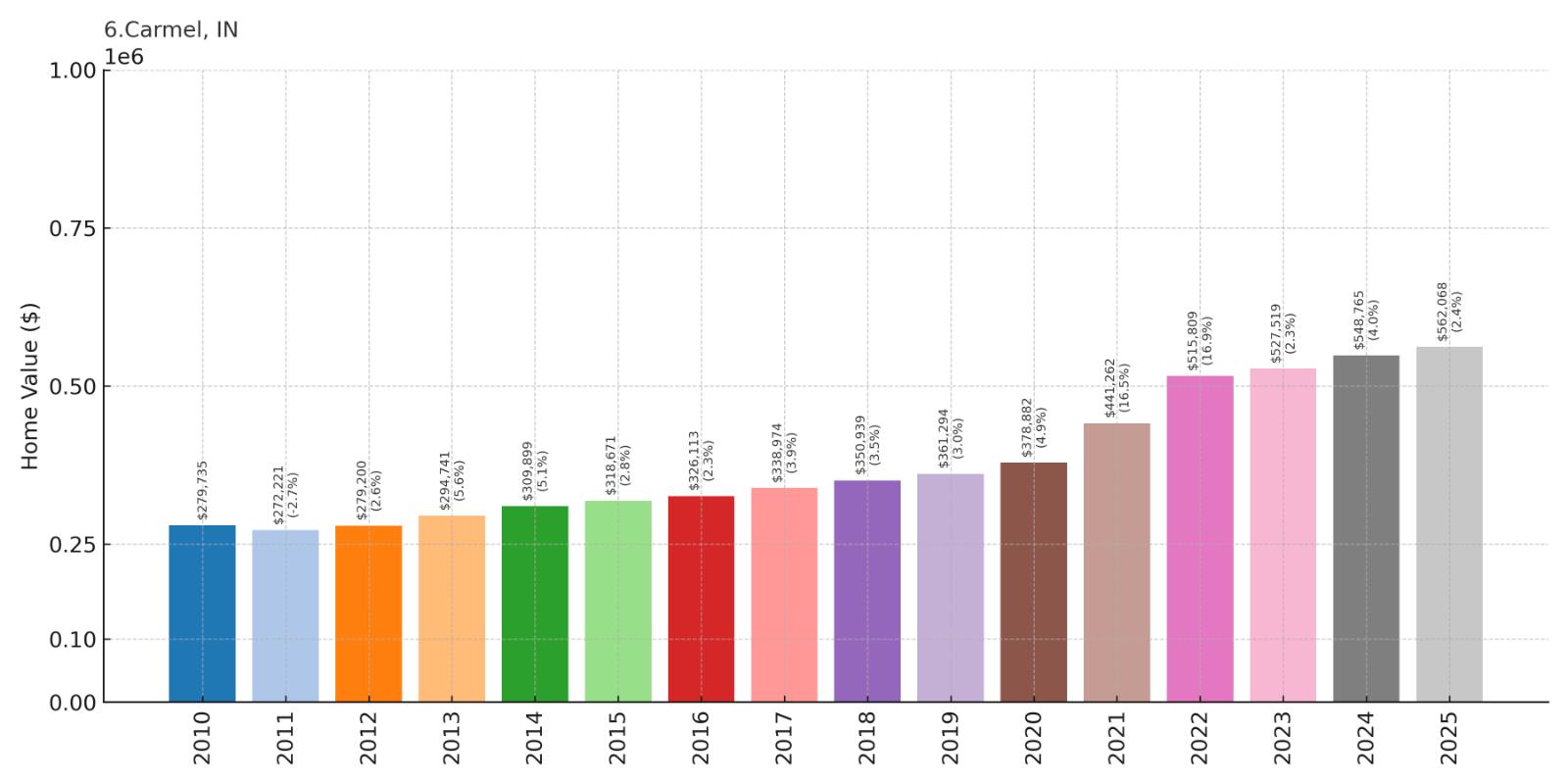
- 2010: $279,735
- 2011: $272,221
- 2012: $279,200
- 2013: $294,741
- 2014: $309,899
- 2015: $318,671
- 2016: $326,113
- 2017: $338,974
- 2018: $350,939
- 2019: $361,294
- 2020: $378,882
- 2021: $441,262
- 2022: $515,809
- 2023: $527,519
- 2024: $548,765
- 2025: $562,068
Carmel has doubled since 2010, reaching $562,068 in 2025 with particularly dramatic growth during and after the pandemic. The Hamilton County city experienced steady appreciation through the 2010s before explosive acceleration starting in 2021. Carmel consistently ranks among the best places to live in America.
Why Carmel?

Why are people willing to pay so much to live here? What’s special about it?
Carmel offers world-class amenities including a performing arts center, extensive park system, and vibrant downtown Arts & Design District with upscale shopping and dining. The Carmel Clay Schools system ranks among Indiana’s finest, while the city features innovative urban planning including 141 roundabouts that have become a signature feature. The combination of cultural sophistication and suburban comfort creates exceptional appeal.
The city provides easy access to Indianapolis employment while maintaining its own thriving business district and corporate headquarters. Residents appreciate the high quality of life, excellent services, and cultural amenities that rival much larger metropolitan areas while maintaining a strong sense of community.
How Carmel Rose to Prominence
Originally called Bethlehem, Carmel was founded in 1837 and renamed in 1874. The community remained a small farming town through the mid-20th century until Indianapolis suburban growth reached Hamilton County in the 1960s. Early development attracted families seeking good schools and larger lots north of Indianapolis.
Carmel’s transformation into a premier destination began in the 1980s under visionary leadership that focused on quality development, excellent schools, and unique amenities. The city became famous for replacing traffic signals with roundabouts, creating a distinctive European feel. Major investments in arts facilities, parks, and downtown redevelopment have made Carmel a model for suburban excellence. The city’s focus on quality of life and innovation has attracted businesses, residents, and national recognition as one of America’s best places to live.
3 Interesting Tidbits
- Roundabout Capital – Carmel features 141 roundabouts, more than any other city in the United States, creating a unique and efficient transportation system.
- Arts Destination – The Palladium at the Center for the Performing Arts rivals venues in major metropolitan areas and attracts world-class performers.
- Corporate Hub – Carmel hosts the headquarters of numerous major corporations, creating a strong local economy and tax base that supports exceptional city services.
5. Michiana Shores – 98% Home Price Increase Since 2010
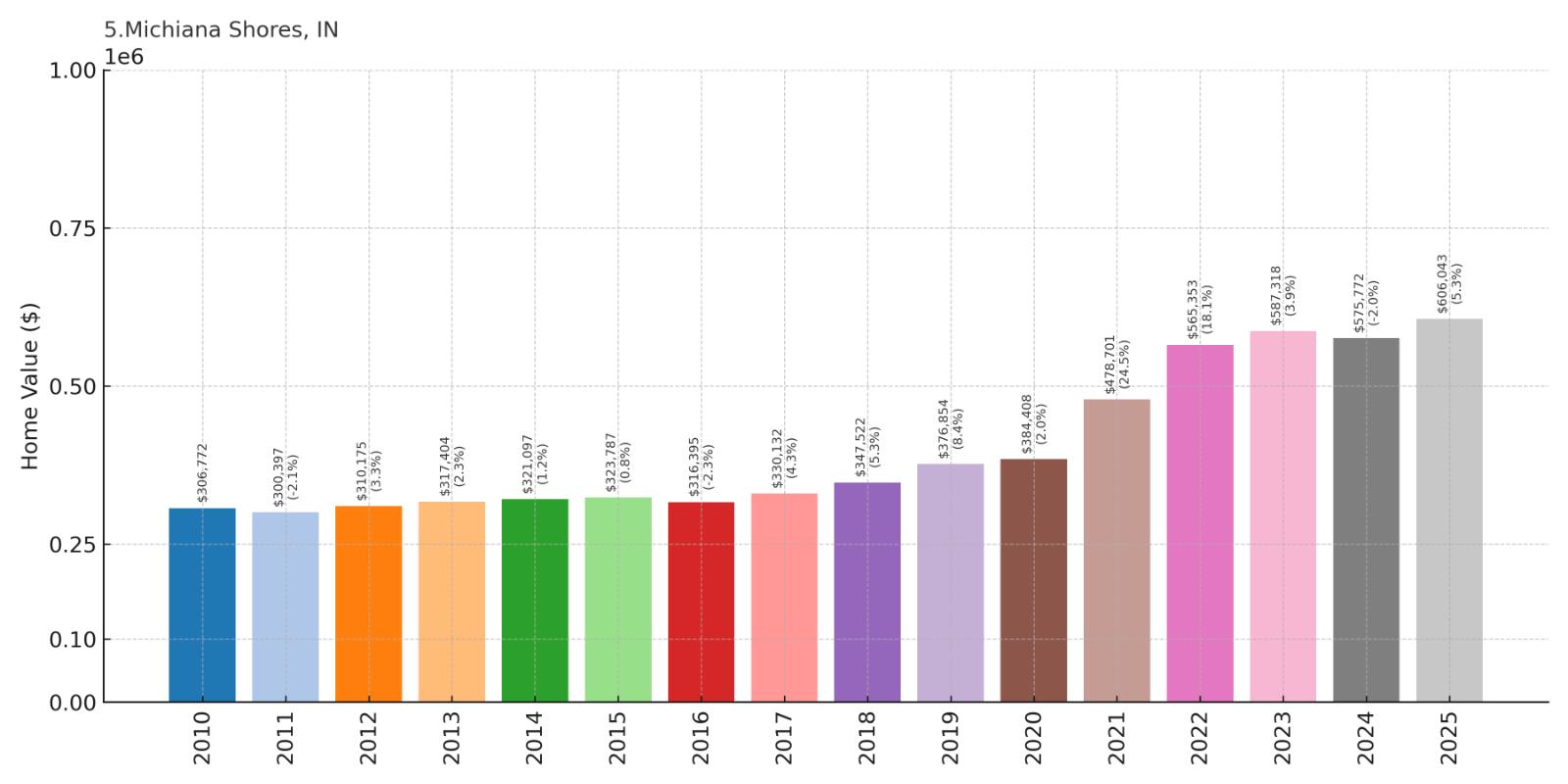
- 2010: $306,772
- 2011: $300,397
- 2012: $310,175
- 2013: $317,404
- 2014: $321,097
- 2015: $323,787
- 2016: $316,395
- 2017: $330,132
- 2018: $347,522
- 2019: $376,854
- 2020: $384,408
- 2021: $478,701
- 2022: $565,353
- 2023: $587,318
- 2024: $575,772
- 2025: $606,043
Michiana Shores has nearly doubled since 2010, reaching $606,043 in 2025 with explosive growth during the pandemic years when values jumped over 55% between 2020 and 2022. The LaPorte County lakefront community benefits from its exclusive location along Lake Michigan with private beach access and proximity to both Chicago and South Bend.
Why Michiana Shores?

Why are people willing to pay so much to live here? What’s special about it?
Michiana Shores offers exclusive lakefront living with private beach access on Lake Michigan, providing a resort-like atmosphere year-round. The community features custom homes on large lots with mature trees and natural landscaping that preserves the area’s scenic beauty. The location provides reasonable access to Chicago employment while offering a completely different lifestyle focused on water recreation and natural beauty.
The town maintains strict development standards and environmental protection that preserve its unique character and lakefront access. Residents appreciate the peaceful, exclusive atmosphere while having access to both Chicago’s urban amenities and the recreational opportunities of Southwest Michigan.
How Michiana Shores Rose to Prominence
Michiana Shores was incorporated in 1966 as an exclusive lakefront community developed from the former summer retreat area along Lake Michigan. The area had attracted Chicago-area residents as a summer destination since the early 20th century, with cottages and seasonal homes dotting the shoreline. The formal incorporation created a municipality focused on preserving lakefront access and natural beauty.
The community has maintained its exclusive character through careful development controls and high property values that naturally limit density. The location between Chicago and South Bend, combined with direct lake access, has made it increasingly attractive to affluent professionals seeking a unique lifestyle. The town’s commitment to environmental protection and selective development has preserved the natural beauty that originally attracted residents.
3 Interesting Tidbits
- Private Beaches – Michiana Shores maintains exclusive beach access for residents, providing uncrowded Lake Michigan shoreline recreation.
- Chicago Connection – Many residents are Chicago-area professionals who choose the community for its lakefront lifestyle and reasonable commuting distance.
- Environmental Focus – The town has long prioritized environmental protection, preserving dunes and natural vegetation while allowing careful development.
4. Zionsville – 104% Home Price Increase Since 2010

- 2010: $320,332
- 2011: $314,647
- 2012: $322,033
- 2013: $336,807
- 2014: $351,134
- 2015: $363,944
- 2016: $376,310
- 2017: $392,070
- 2018: $406,752
- 2019: $429,092
- 2020: $440,133
- 2021: $507,188
- 2022: $598,391
- 2023: $604,125
- 2024: $626,846
- 2025: $653,029
Zionsville has more than doubled since 2010, reaching $653,029 in 2025 with dramatic acceleration during the pandemic years. The Boone County town experienced steady growth through the 2010s before explosive appreciation starting in 2021. Known for its historic charm and equestrian culture, Zionsville combines small-town character with upscale amenities.
Why Zionsville?

Why are people willing to pay so much to live here? What’s special about it?
Zionsville offers a unique combination of historic downtown charm, equestrian culture, and upscale suburban amenities that create exceptional appeal. The brick-paved Main Street features boutique shopping, fine dining, and community events while the surrounding area offers horse farms, trails, and rural beauty. The Zionsville Community Schools system ranks among Indiana’s best, making it highly attractive to families.
The town successfully preserves its historic character while accommodating growth, maintaining large lots and tree-lined streets that create a distinctive atmosphere. Residents appreciate the equestrian culture, with numerous horse farms and riding trails that provide a unique suburban experience rarely found in other communities.
How Zionsville Rose to Prominence
Zionsville was founded in 1852 by William Zion, developing as a railroad town along the Indianapolis and Lafayette line. The community’s distinctive brick Main Street was built in the early 20th century and has become its signature feature. The town remained primarily agricultural with a small commercial center until suburban development reached Boone County in the 1960s.
Growth accelerated in the 1980s and 1990s as families discovered Zionsville’s combination of excellent schools, historic charm, and horse-friendly culture. The area’s large lots and rural atmosphere attracted affluent residents seeking alternatives to traditional suburban developments. Careful preservation of the historic downtown and equestrian character has maintained Zionsville’s unique identity while accommodating significant residential growth, making it one of Indiana’s most prestigious communities.
3 Interesting Tidbits
- Brick Street Main Street – Zionsville’s historic brick Main Street, paved in the early 1900s, creates a distinctive small-town atmosphere that attracts visitors from across the region.
- Horse Country – The town is known for its equestrian culture, with numerous horse farms, boarding facilities, and riding trails throughout the area.
- Historic Preservation – Zionsville has successfully balanced growth with historic preservation, maintaining its unique character while becoming one of Indiana’s most expensive communities.
3. Clear Lake – 104% Home Price Increase Since 2010

- 2010: $359,945
- 2011: $365,804
- 2012: $367,599
- 2013: $364,213
- 2014: $388,812
- 2015: $408,088
- 2016: $418,879
- 2017: $420,990
- 2018: $433,530
- 2019: $472,896
- 2020: $494,374
- 2021: $576,438
- 2022: $675,418
- 2023: $708,382
- 2024: $708,711
- 2025: $734,084
Clear Lake has more than doubled since 2010, reaching $734,084 in 2025 with remarkable acceleration during the pandemic years. The Steuben County lakefront community experienced steady growth through the 2010s before explosive appreciation starting in 2019. This exclusive community offers pristine lake living in northeast Indiana.
Why Clear Lake?

Why are people willing to pay so much to live here? What’s special about it?
Clear Lake provides exclusive lakefront living on one of Indiana’s most pristine natural lakes, offering crystal-clear water, excellent fishing, and premium recreational opportunities. The community features custom lakefront homes with private docks and sandy beaches rarely found in the Midwest. The area attracts affluent retirees and families seeking a resort-like lifestyle year-round.
The lake’s exceptional water quality and scenic beauty create a unique environment that commands premium prices. Residents enjoy boating, swimming, and fishing in an exclusive setting while having reasonable access to Fort Wayne and other regional employment centers.
How Clear Lake Rose to Prominence
Clear Lake developed as a summer retreat destination in the early 20th century, attracting wealthy families from Fort Wayne, Indianapolis, and Chicago seeking pristine lake recreation. The area remained primarily seasonal through mid-century, with cottages and summer homes dotting the shoreline. Year-round development began in the 1960s as improved transportation made the area more accessible.
The community’s transformation into an exclusive year-round destination accelerated in the 1980s and 1990s as lake properties throughout the Midwest became increasingly valuable. Clear Lake’s exceptional water quality and natural beauty attracted affluent buyers willing to pay premium prices for lakefront access. The limited development around the lake has preserved its exclusive character while driving values to among the highest in Indiana.
3 Interesting Tidbits
- Pristine Waters – Clear Lake is renowned for its exceptional water clarity and quality, making it one of the most desirable lake communities in the Midwest.
- Limited Development – Strict development controls have preserved the lake’s natural beauty and exclusive character, maintaining property values and environmental quality.
- Resort Lifestyle – Many residents treat Clear Lake as a permanent resort destination, with amenities and lifestyle focused on water recreation and natural beauty.
2. Long Beach – 98% Home Price Increase Since 2010
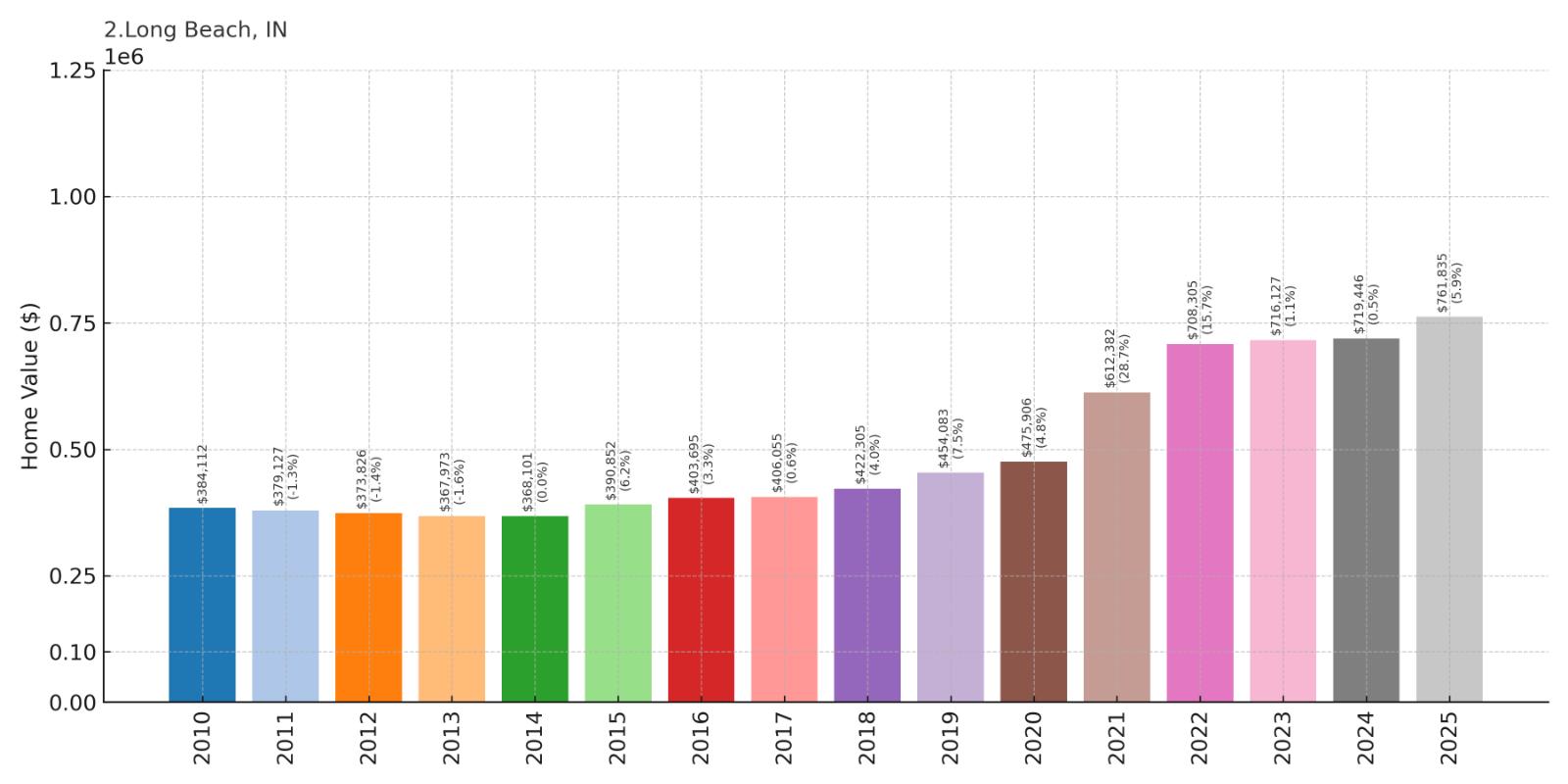
- 2010: $384,112
- 2011: $379,127
- 2012: $373,826
- 2013: $367,973
- 2014: $368,101
- 2015: $390,852
- 2016: $403,695
- 2017: $406,055
- 2018: $422,305
- 2019: $454,083
- 2020: $475,906
- 2021: $612,382
- 2022: $708,305
- 2023: $716,127
- 2024: $719,446
- 2025: $761,835
Long Beach has nearly doubled since 2010, reaching $761,835 in 2025 with explosive growth during the pandemic when values jumped over 60% between 2020 and 2022. The LaPorte County lakefront town started from a high baseline reflecting its premium Lake Michigan location. This exclusive community offers direct beach access and stunning lake views just an hour from Chicago.
Why Long Beach?

Why are people willing to pay so much to live here? What’s special about it?
Long Beach provides exclusive Lake Michigan frontage with private beaches, stunning sunsets, and premium waterfront homes that rival coastal properties anywhere in the country. The community offers a true beach town atmosphere with sandy shores, dunes, and lake access that creates a resort-like environment year-round. The location provides reasonable access to Chicago employment while offering a completely different lifestyle.
Residents enjoy world-class recreational opportunities including sailing, fishing, and beach activities while maintaining the sophisticated amenities expected in a premium community. The combination of natural beauty and exclusivity creates some of Indiana’s most valuable real estate.
How Long Beach Rose to Prominence
Long Beach was established in the 1920s as an exclusive lakefront development along Lake Michigan. The community was designed as a summer retreat for wealthy Chicago-area families seeking pristine beach access and lake recreation. Early development featured large lots and custom homes positioned to take advantage of lake views and beach access.
The town incorporated in 1966 to maintain local control over development and preserve its exclusive character. Throughout the decades, Long Beach has attracted affluent residents seeking a unique lakefront lifestyle with urban access. The community’s commitment to preserving its natural beauty and exclusive atmosphere has made it one of the most expensive and desirable locations in Indiana, particularly attractive during the pandemic as remote work made lakefront living more feasible.
3 Interesting Tidbits
- Private Beaches – Long Beach maintains exclusive beach access for residents, providing uncrowded Lake Michigan shoreline with premium sand and swimming areas.
- Chicago Escape – Many residents are Chicago professionals who use Long Beach as either a primary residence or luxury retreat from urban living.
- Architectural Heritage – The community features distinctive lakefront architecture from multiple eras, creating a unique and valuable housing stock with historic character.
1. Dune Acres – 55% Home Price Increase Since 2016
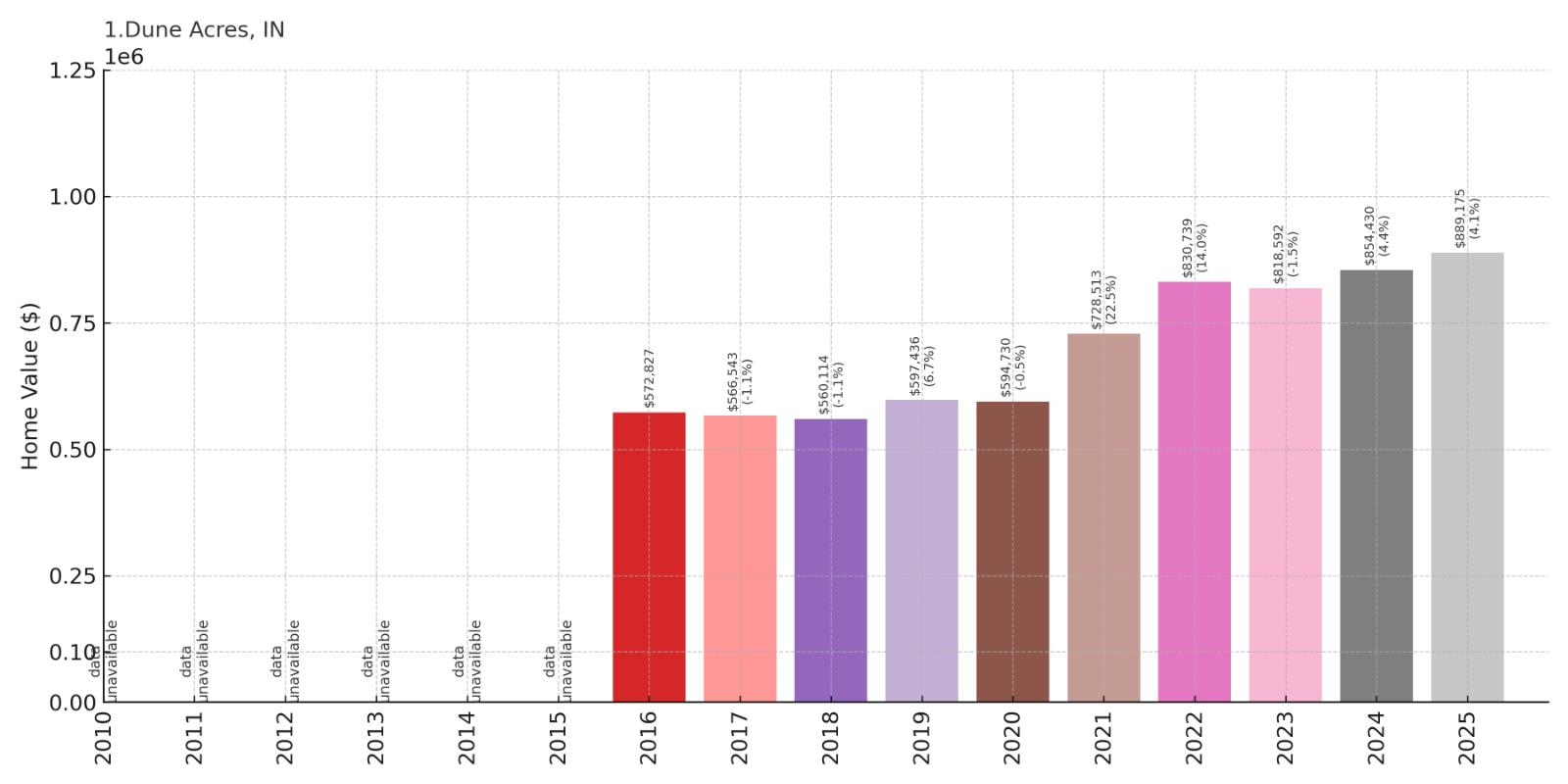
- 2010: N/A
- 2011: N/A
- 2012: N/A
- 2013: N/A
- 2014: N/A
- 2015: N/A
- 2016: $572,827
- 2017: $566,543
- 2018: $560,114
- 2019: $597,436
- 2020: $594,730
- 2021: $728,513
- 2022: $830,739
- 2023: $818,592
- 2024: $854,430
- 2025: $889,175
Dune Acres tops Indiana’s most expensive communities at $889,175 in 2025, with 55% growth since 2016 when data first became available. The Porter County lakefront town experienced dramatic acceleration during the pandemic years, with values jumping over 40% between 2020 and 2022. This ultra-exclusive Lake Michigan community represents the pinnacle of Indiana luxury real estate.
Why Dune Acres?

Why are people willing to pay so much to live here? What’s special about it?
Dune Acres offers the ultimate in exclusive lakefront living with direct Lake Michigan access, pristine beaches, and protected dunes ecosystem. The community features custom estates on large lots with unobstructed lake views and private beach access that creates a truly unique living experience. The location provides reasonable access to Chicago while offering complete privacy and natural beauty.
The town maintains the strictest development controls in Indiana, preserving the natural dunes landscape while allowing carefully planned luxury development. Residents enjoy a resort lifestyle year-round with world-class recreational opportunities and environmental protection that ensures the community’s character for generations.
How Dune Acres Rose to Prominence
Dune Acres was established in 1923 as an exclusive planned community designed around the natural Lake Michigan dunes landscape. The development was created specifically for affluent Chicago-area families seeking a pristine lakefront retreat with environmental protection and exclusive access. The community incorporated in 1925 with strict environmental covenants and development controls.
Throughout its history, Dune Acres has maintained its position as one of the Midwest’s most exclusive communities through careful preservation of its natural beauty and selective development. The town survived economic downturns while attracting successive generations of affluent residents who value environmental protection and lakefront exclusivity. Its combination of natural beauty, environmental stewardship, and ultra-exclusive character has made it Indiana’s most expensive community and one of the most unique residential destinations in the Midwest.
3 Interesting Tidbits
- Environmental Pioneer – Dune Acres was one of the first communities in America designed around environmental protection, preserving natural dunes while allowing carefully planned development.
- Ultra-Exclusive – With fewer than 200 homes, Dune Acres maintains one of the most exclusive residential environments in the Midwest.
- Natural Preservation – The community has preserved over 60% of its land as natural dunes and woodland, creating a unique balance between luxury living and environmental stewardship.






